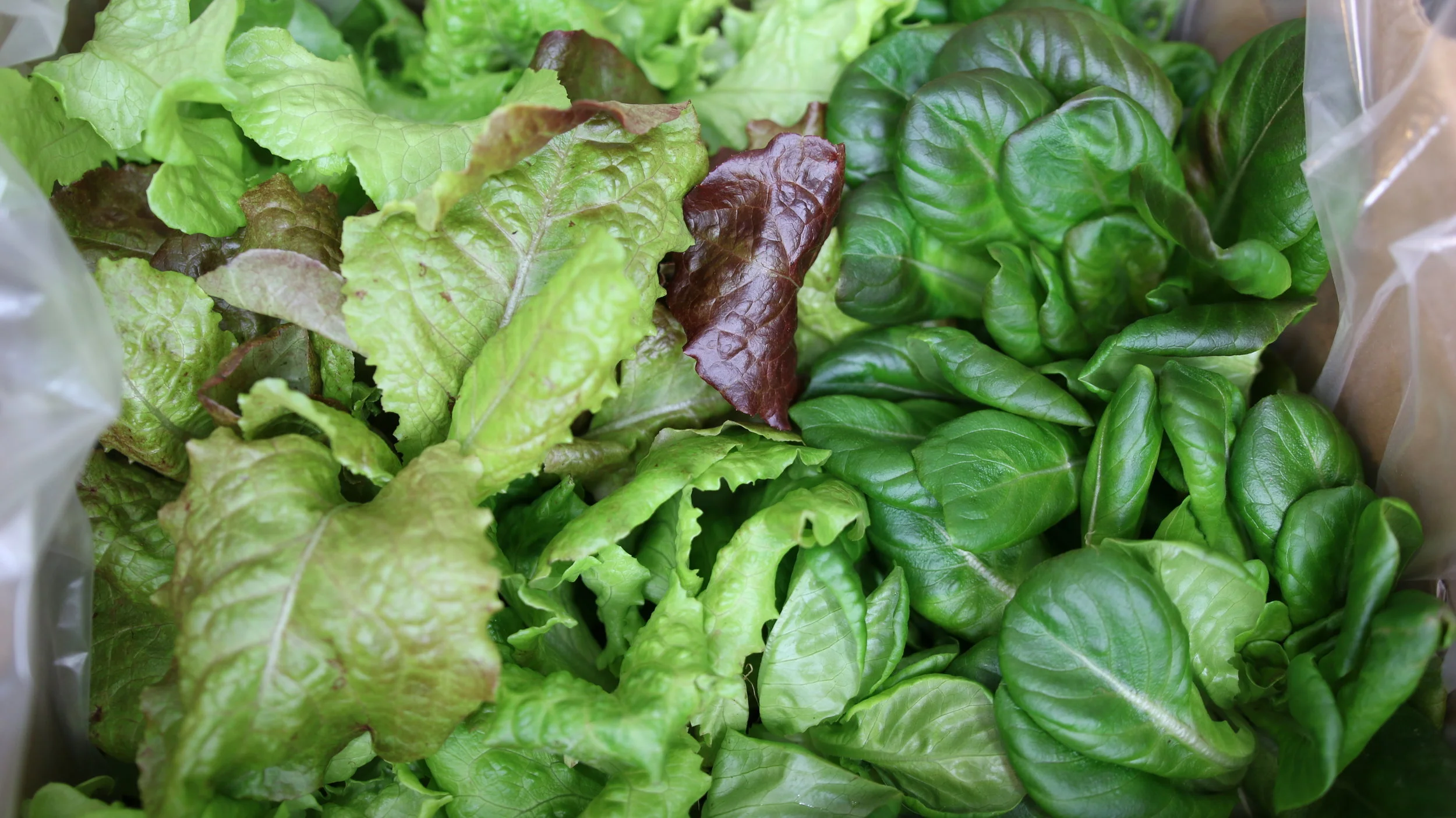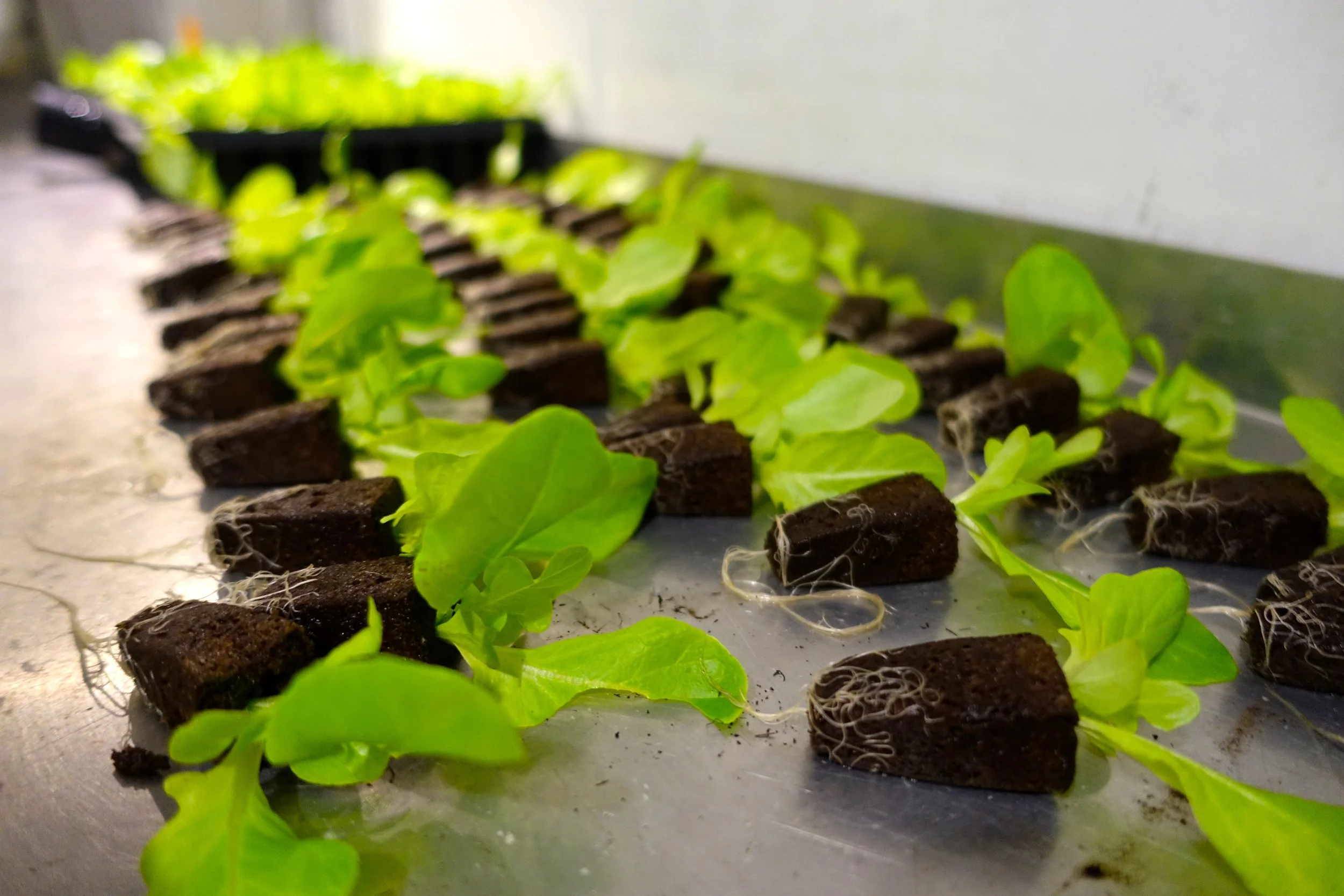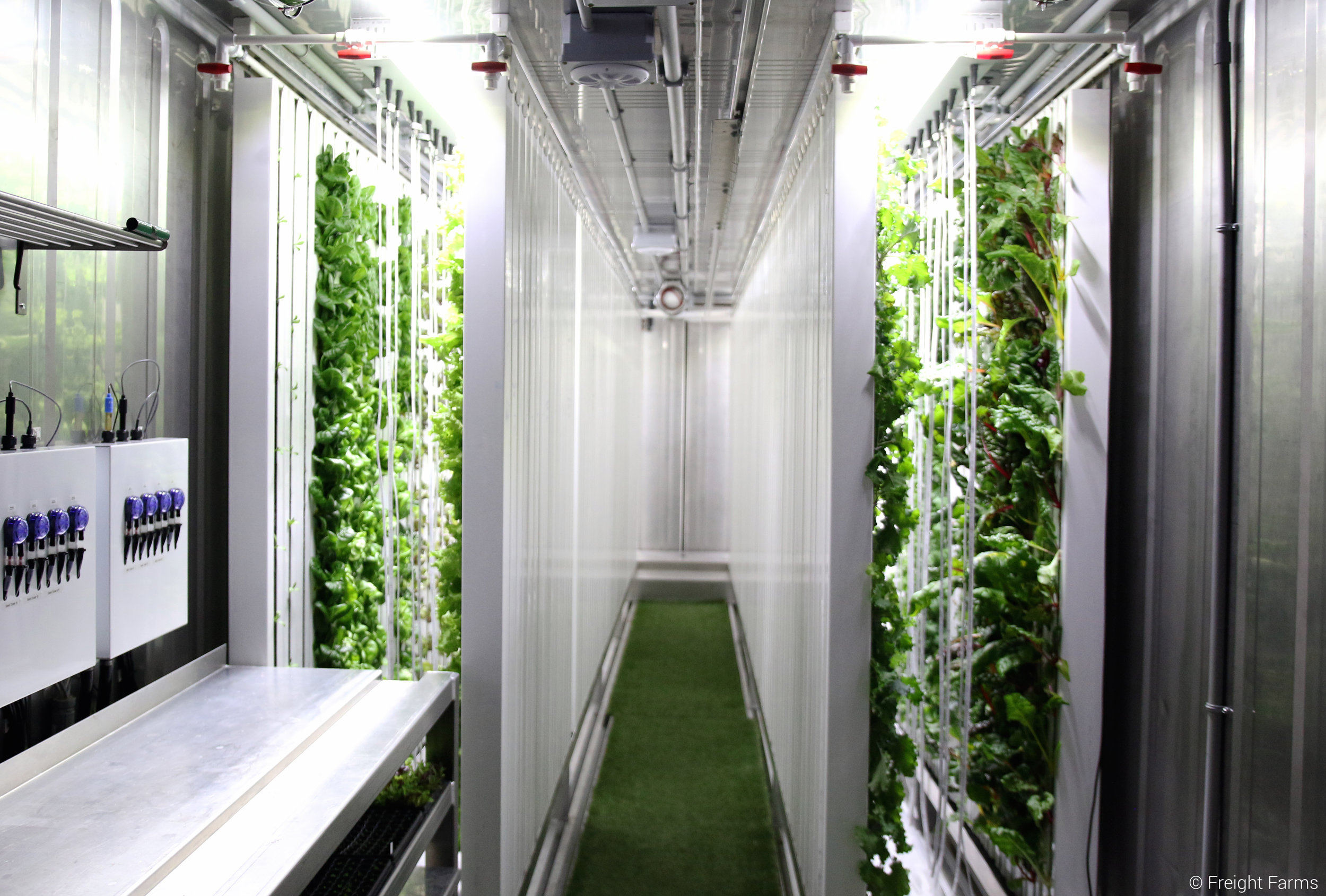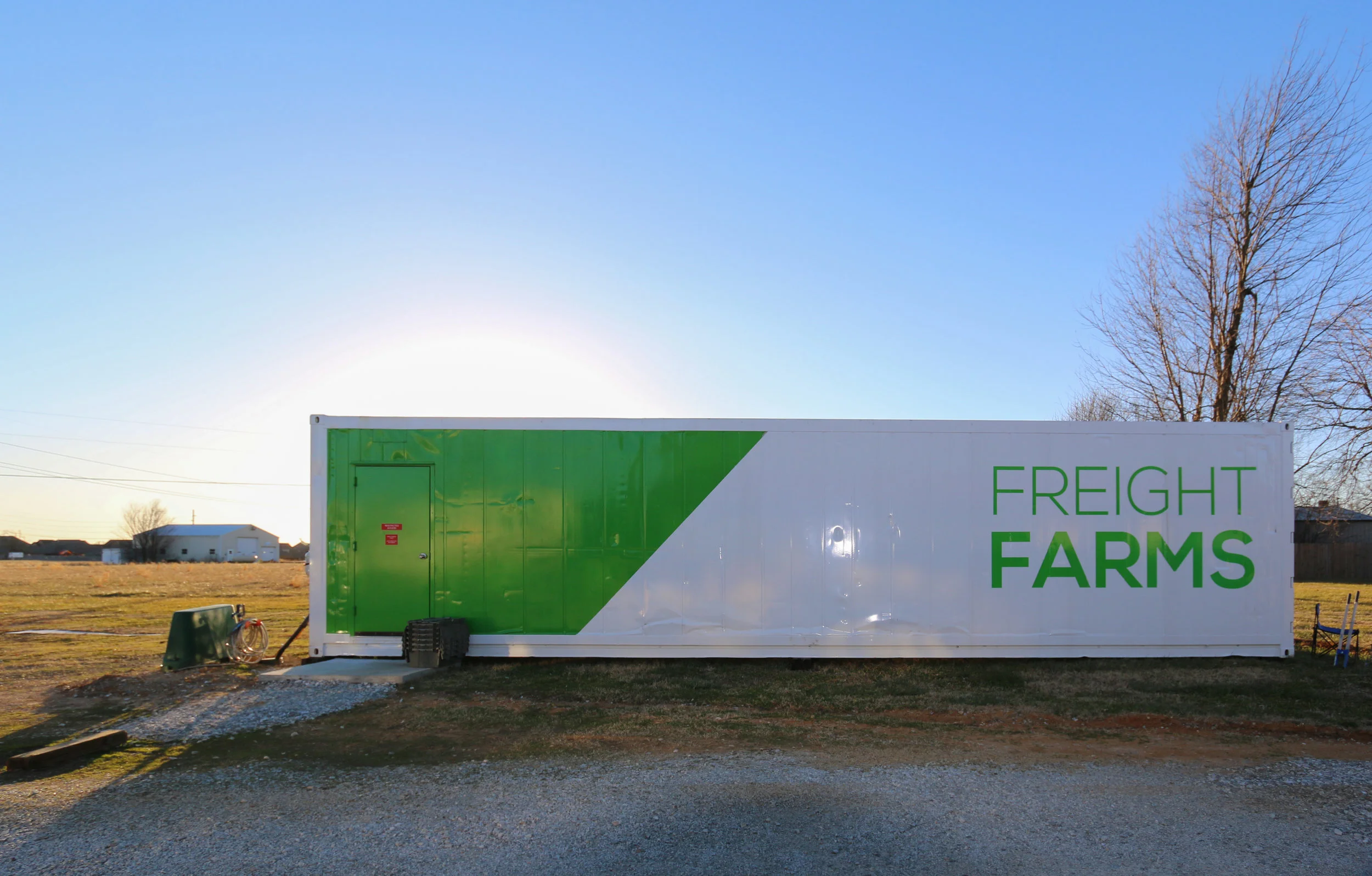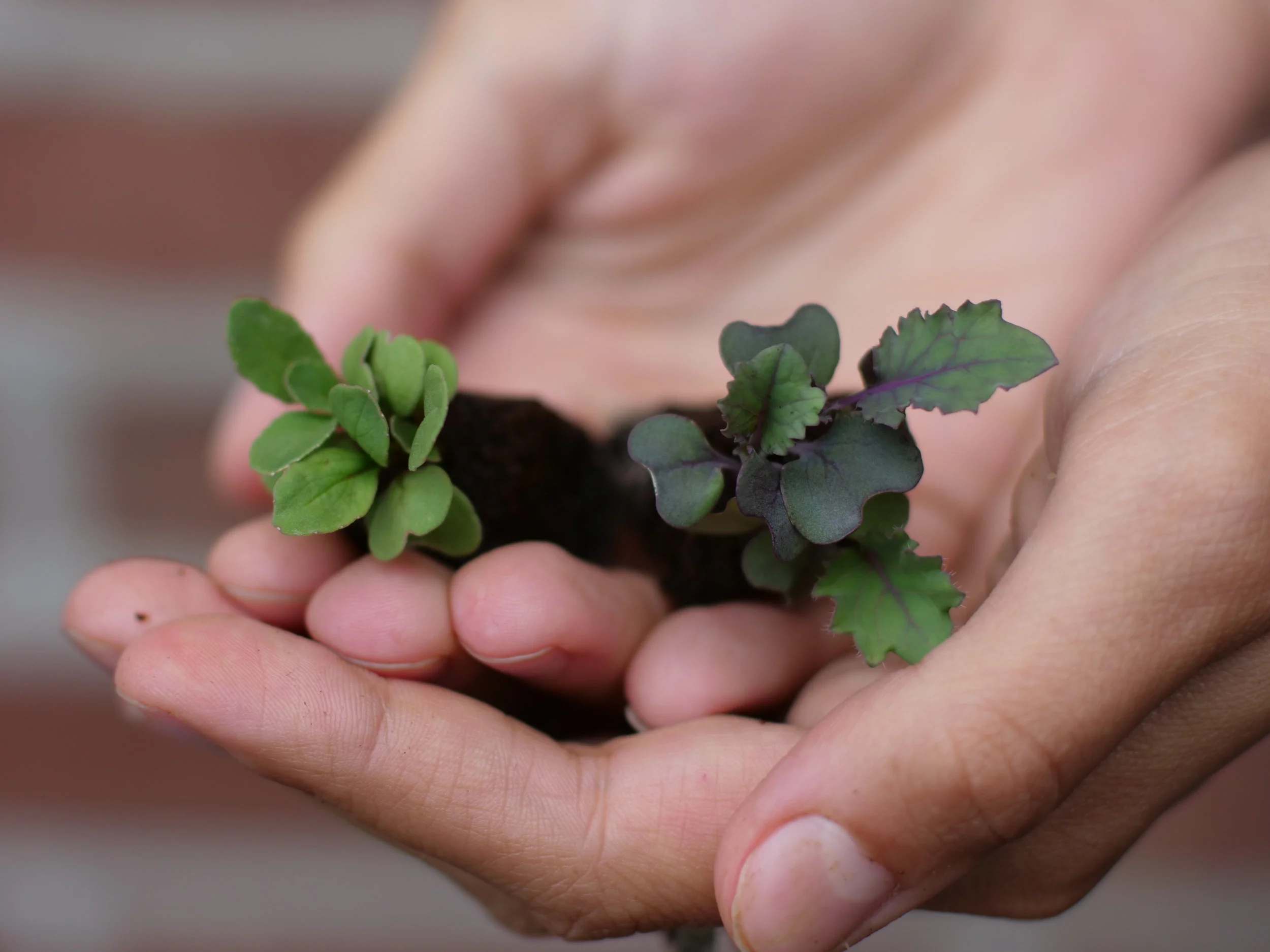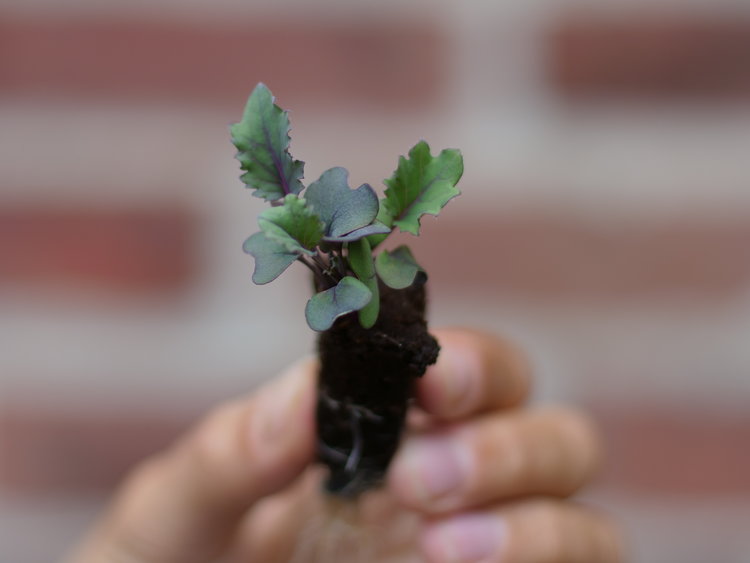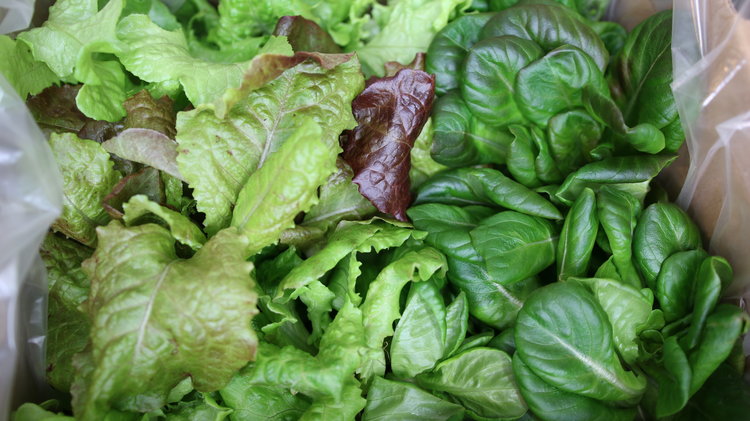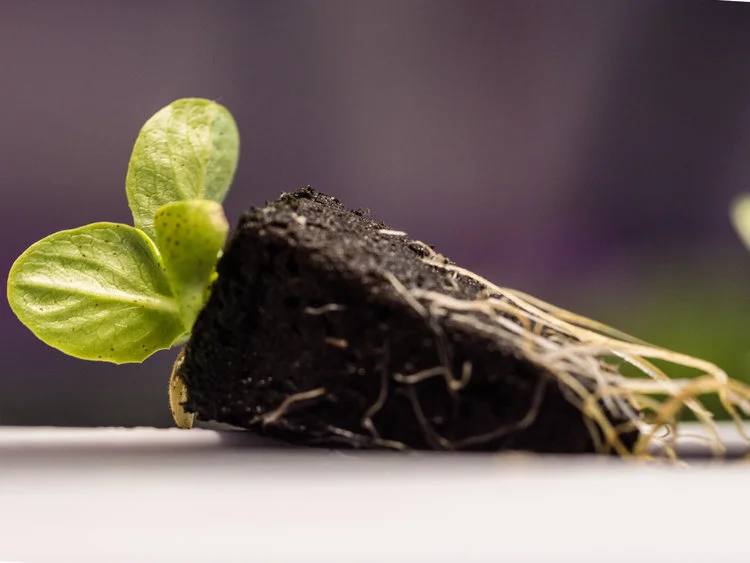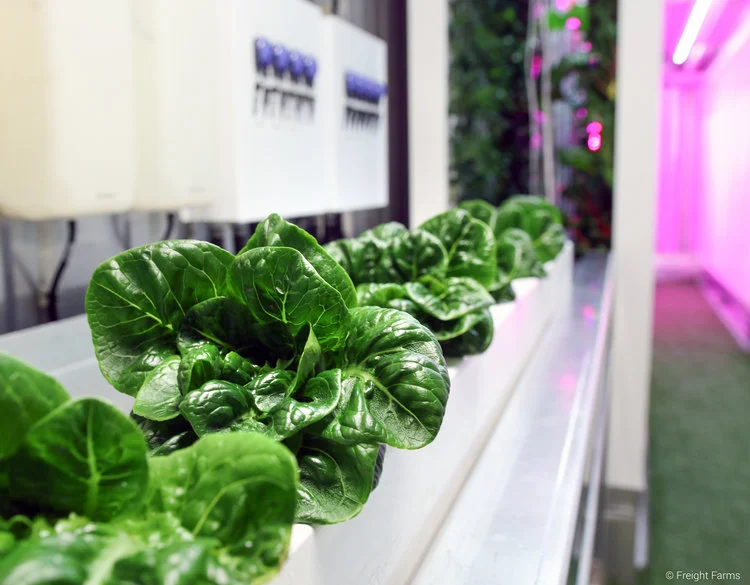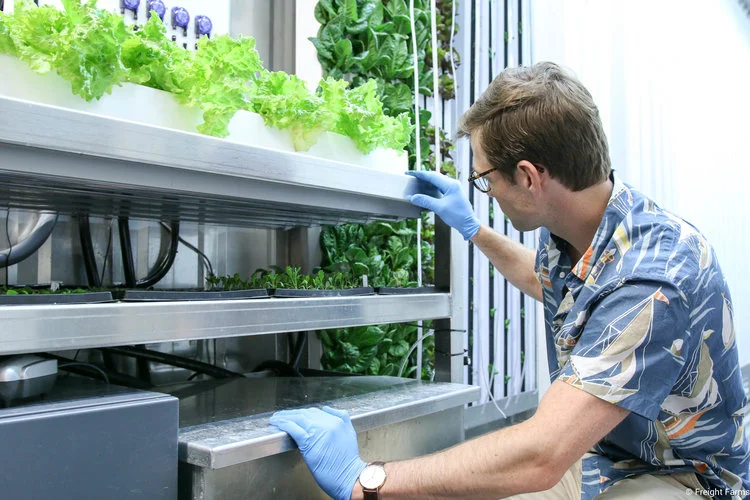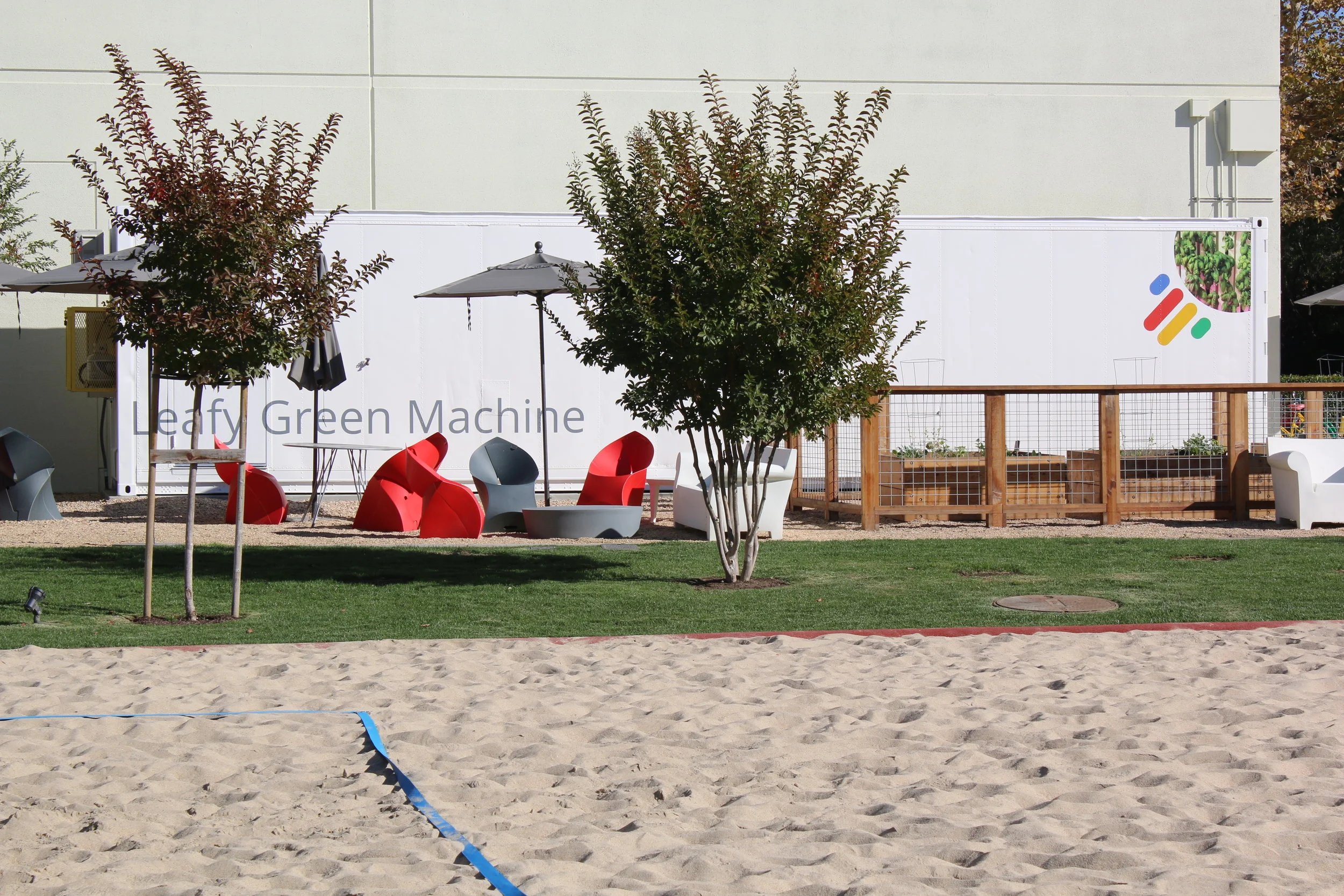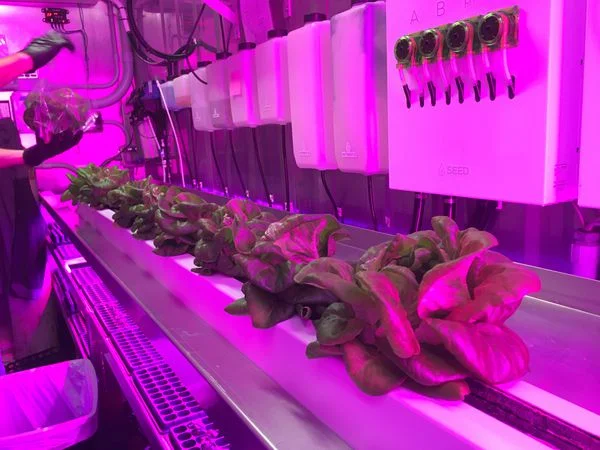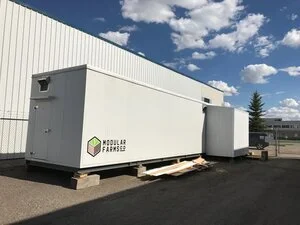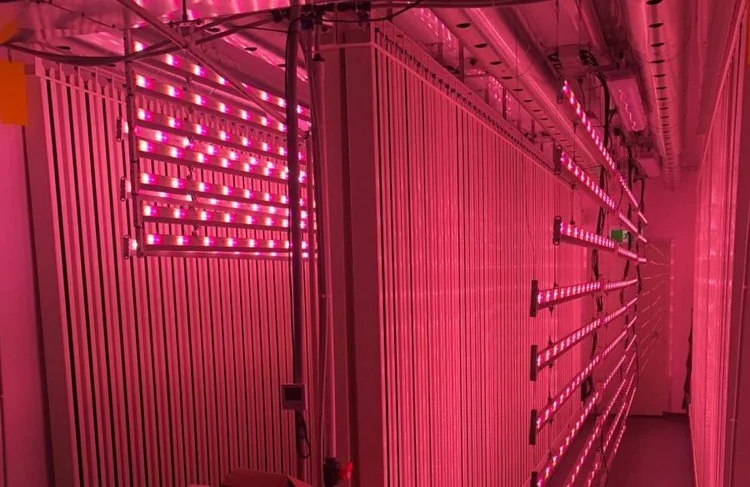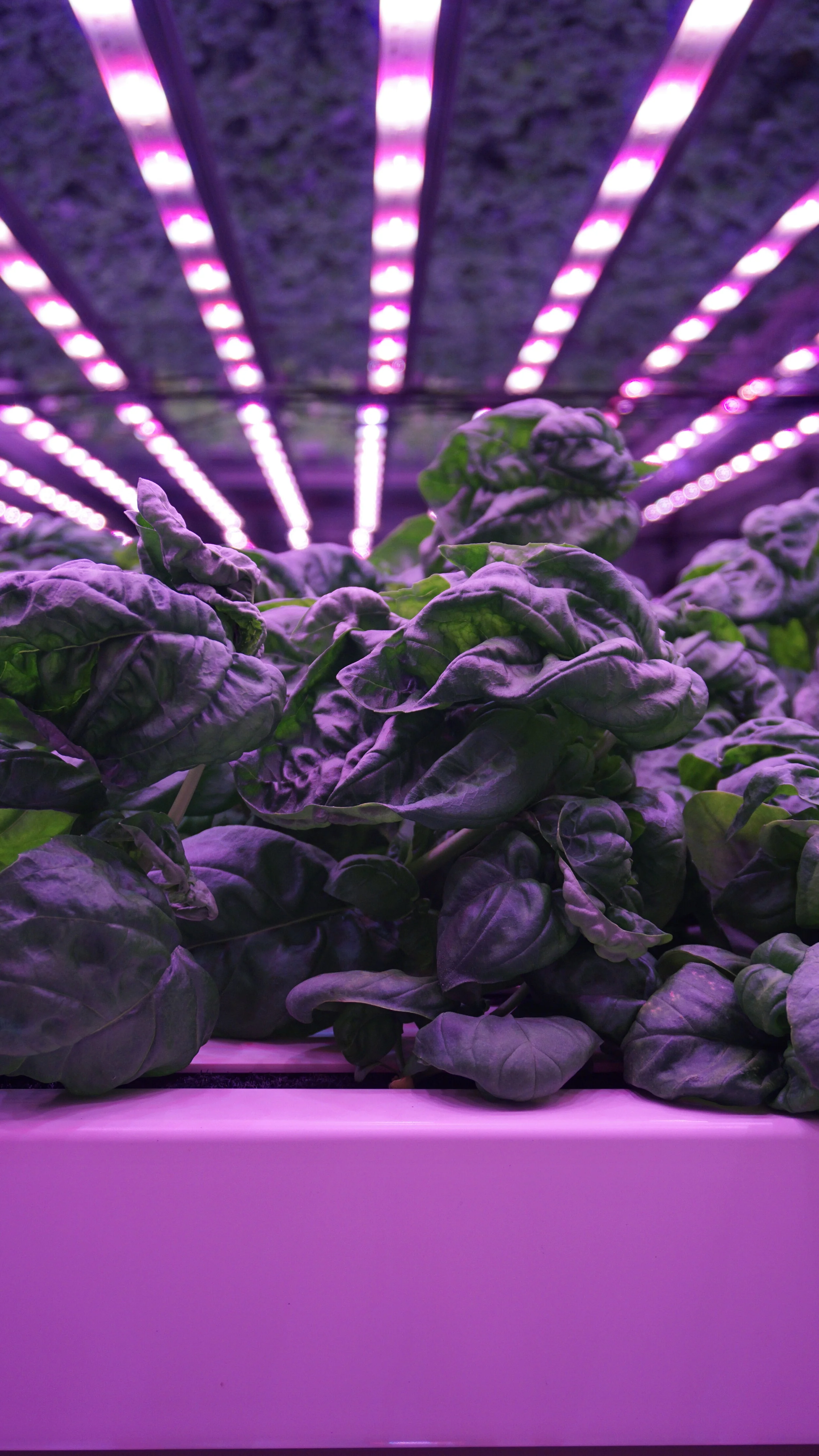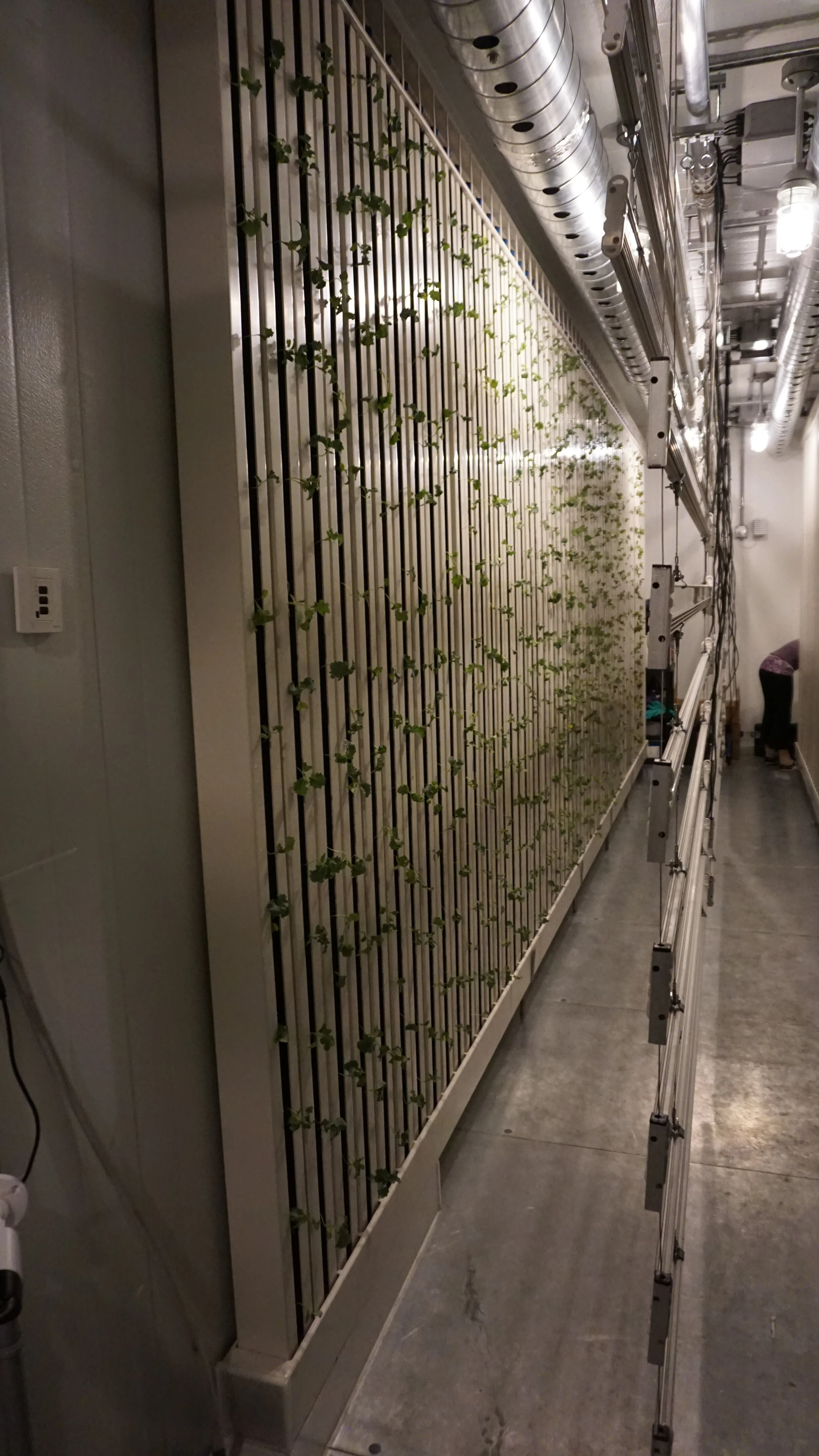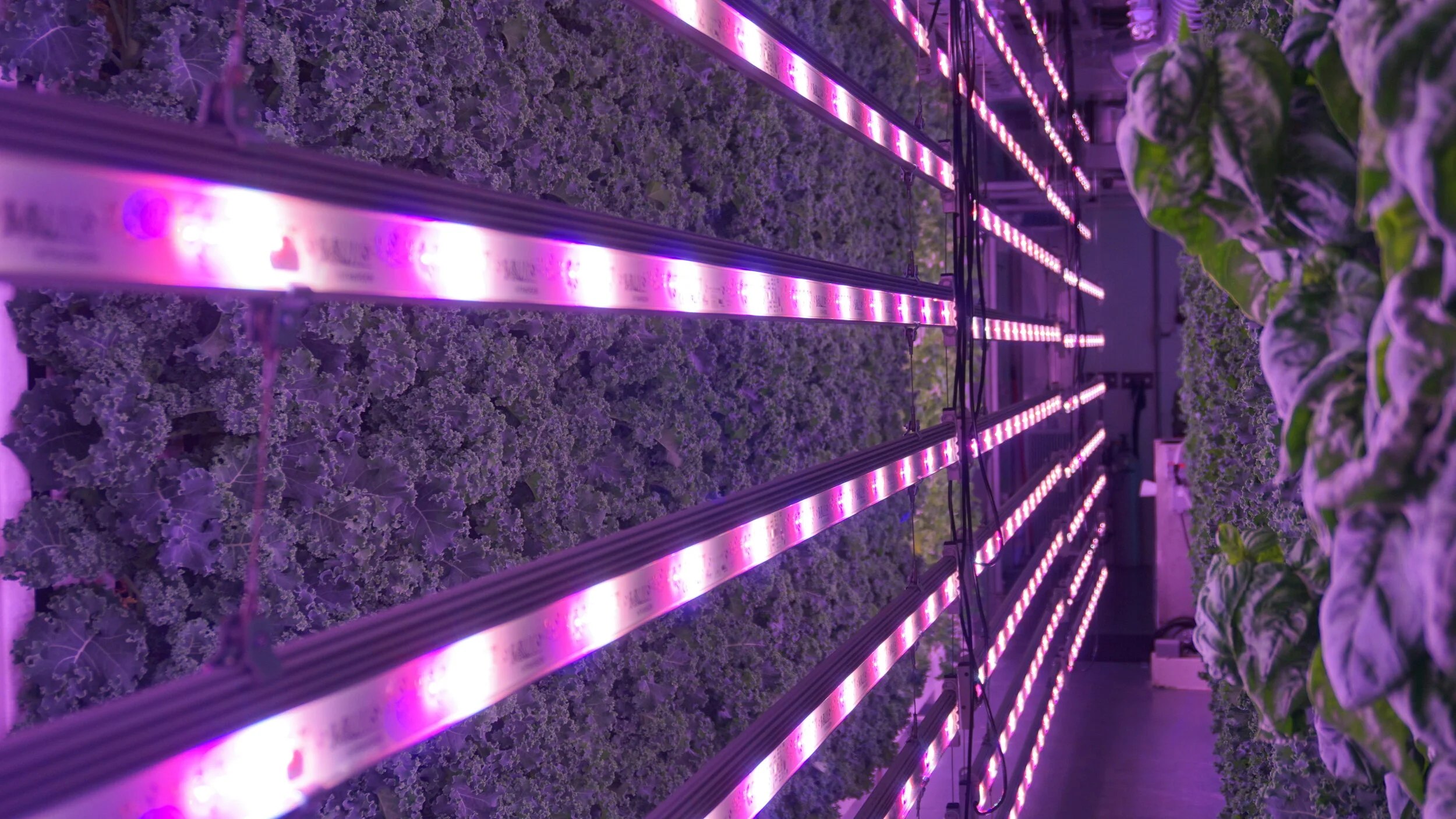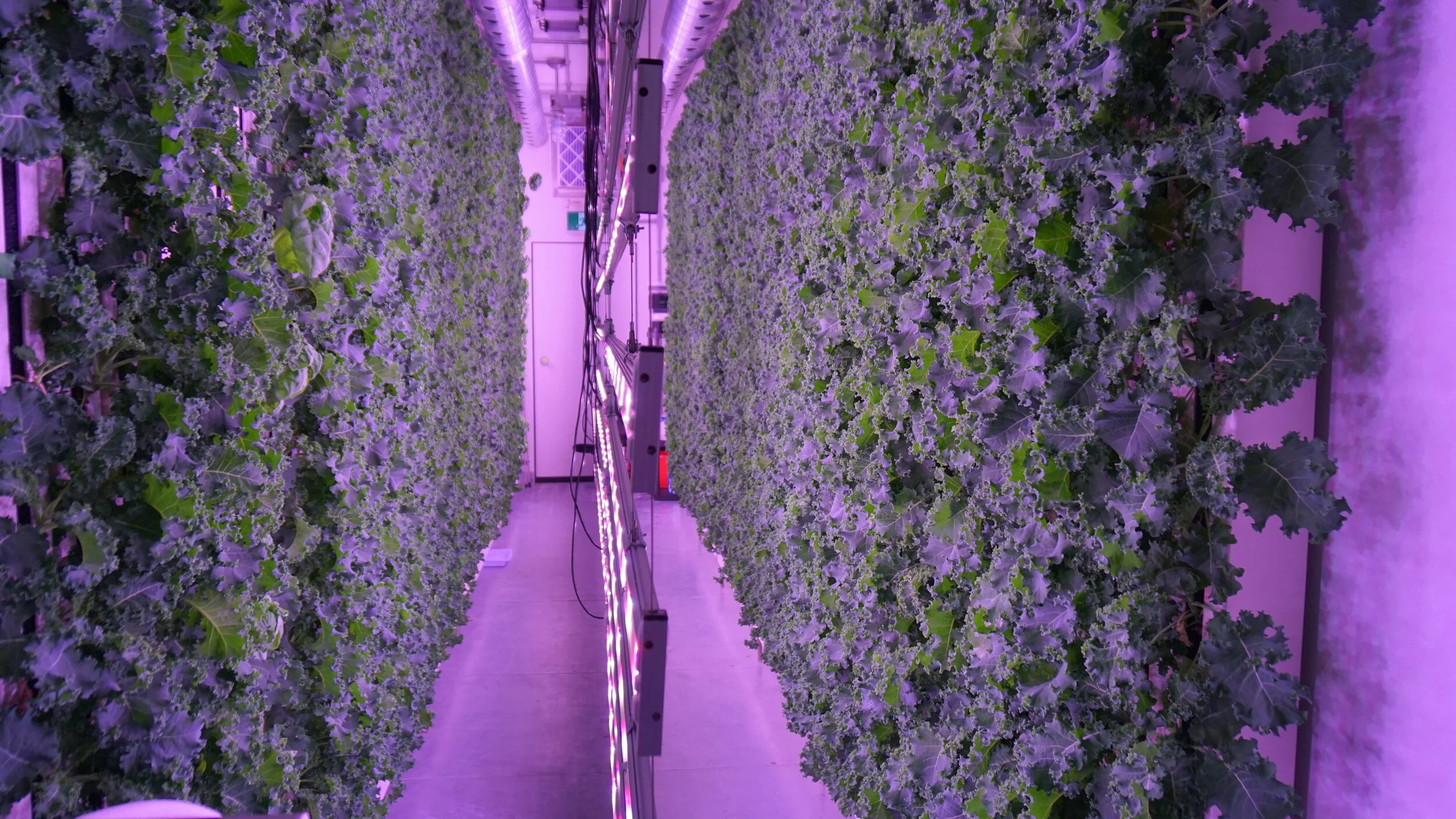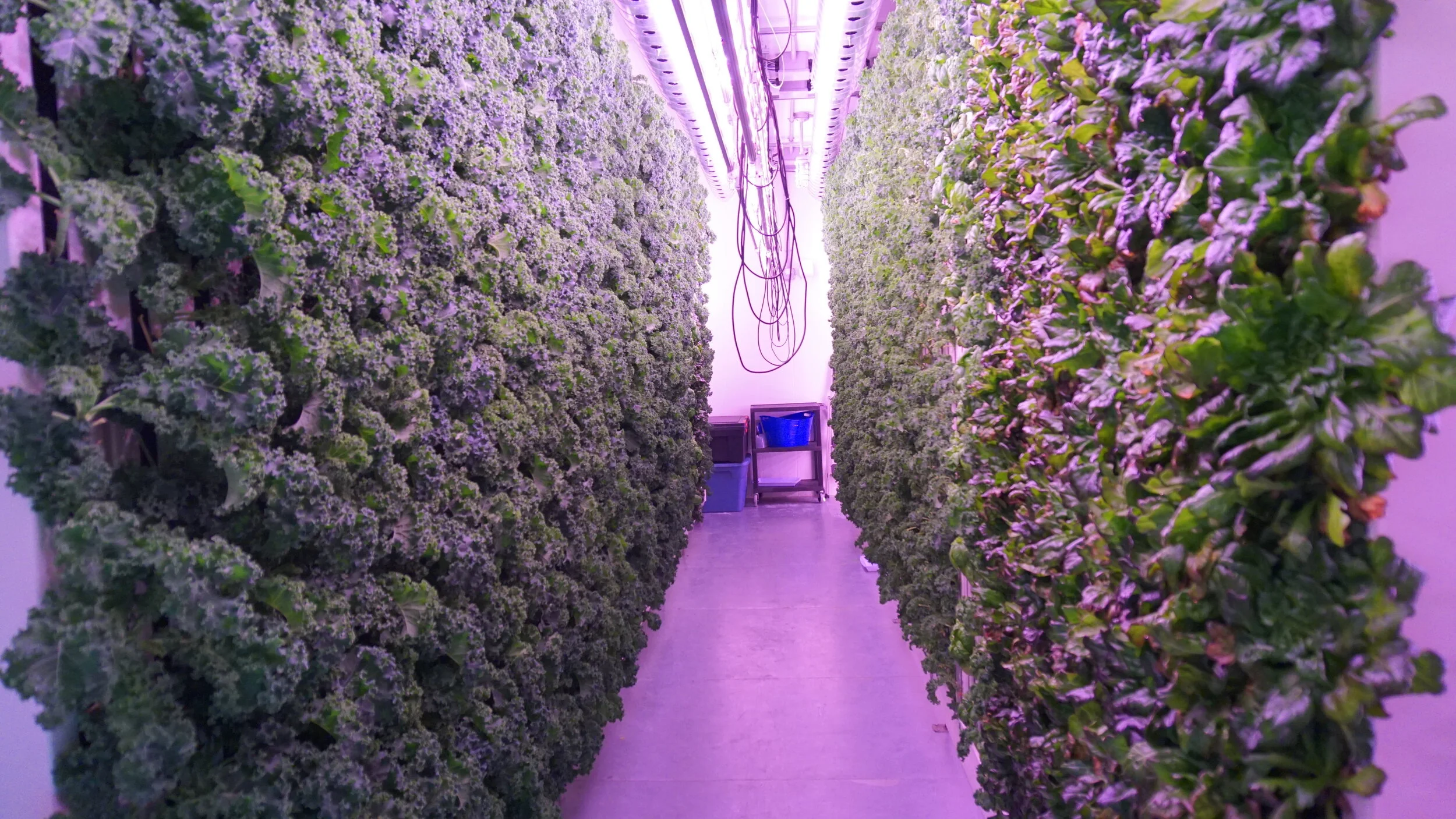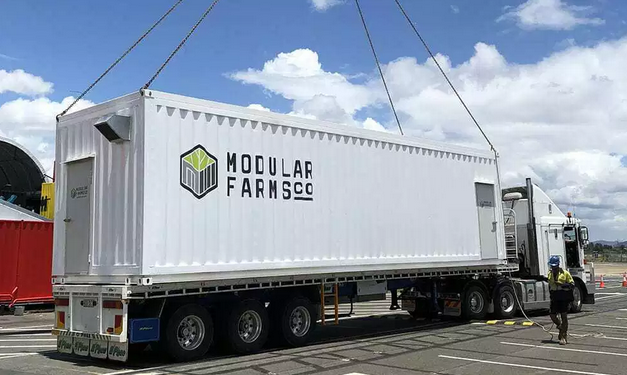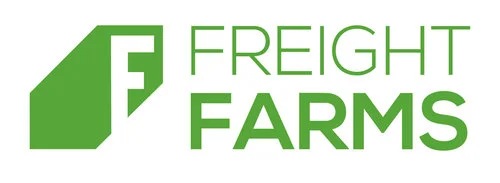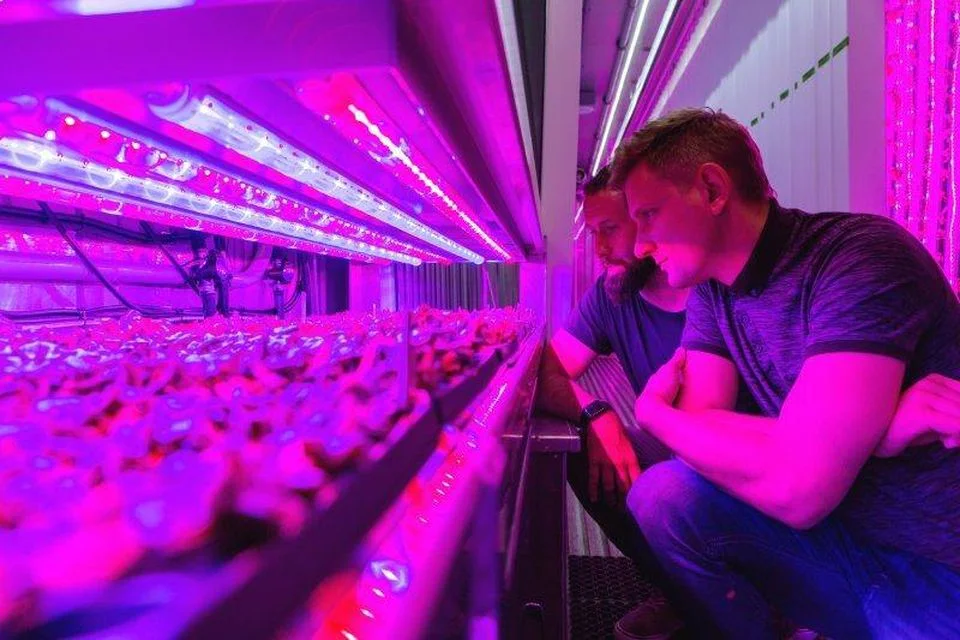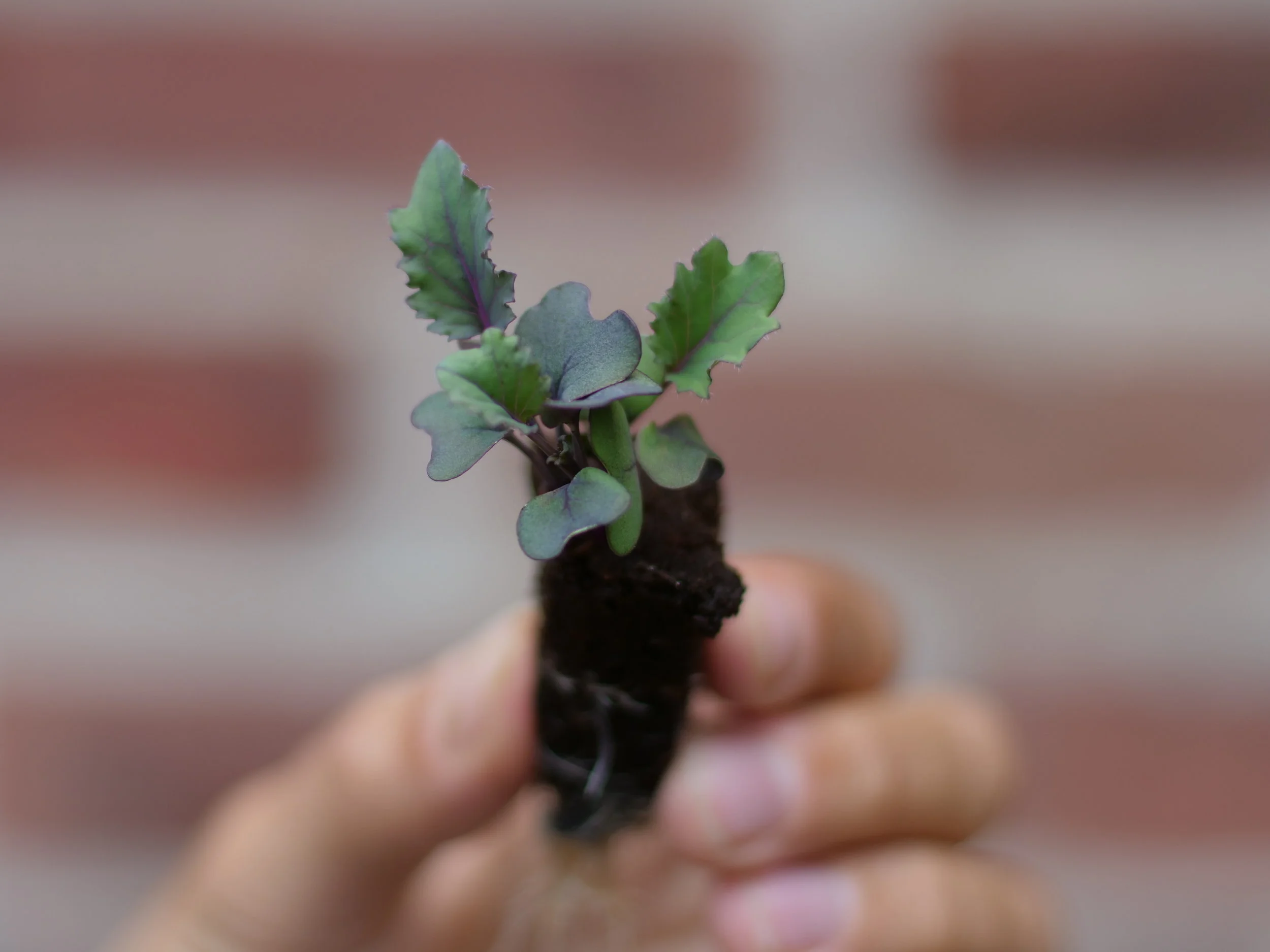
Welcome to iGrow News, Your Source for the World of Indoor Vertical Farming
FOR SALE - 2017.5 Freight Farm - Computer Controlled Hydroponic Grow System - Ann Arbor, Michigan
Make & Model - 2017.5 Leafy Green Machine (LGM) - Winterized" for Cold Climates.
Manufacturer - Freight Farms
Location - Ann Arbor, Michigan
Price - $70,000
Description
Well maintained 2017.5 LGM purchased from Freight Farms.
This LGM has been a reliable producer of healthy produce.
LGM Included Accessories:
Harvest Track
CO2 Booster
Storage Cabinet
Video Camera
Blue Tooth Audio Speakers
Hand Sink Package
Dehumidifier w/Reclamation Package
Water Filter Package
ELFA shelves installed
AC condensate water recycling system in place with Filters
Farm tutorial
Farm Hand App setup
The Leafy Green Machine is a complete hydroponic growing system built entirely inside a shipping container with all the components needed for commercial food production. The system is designed and engineered for easy operation, allowing users of all backgrounds to immediately start growing.
Current Uses
• Perfect for starting a small produce business, growing for restaurants or supplementing existing produce production.
• Restauranter who wants to grow custom greens for rotating menus 365 days a year. Farm to Table? How about Parking Lot to Table!
• Universities and schools have created programs for students to learn to grow while supplementing dining facilities with fresh greens.
The Highest Standard in Controlled Environment Agriculture
• Pre-built system designed to maximize operational efficiency and streamline workflow
• Perfect environment is achievable 365 days a year, regardless of geographic location
• Automated scheduling reduces the amount of labor required to operate
• Remote monitoring & control capabilities through the Farmhand AppTM
Operation Requirements
Space- The LGM dimensions are 40’ x 8’ x 9.5’. We suggest putting the farm on either trap rock or a concrete pad.
Electrical- 60 amp, 120/240-volt single phase or 120/208V three phase connection.
Water- A designated water source is suggested such as a garden hose or hardline water plumbing.
Labor- 15 to 20 hours a week for farming and upkeep.
It is recommended growing smaller compact crops with a high turnover rate, like head and loose leaf lettuces, herbs and heartier greens like kale and swiss chard.
Crop Examples
Butterhead lettuce, Oakleaf lettuce, Swiss Chard, Mustard Greens, Cabbage Leaves, Arugula, Cilantro, Mint, Dill, Oregano, Kale, Endive, Basil, Chives and Thyme
Yields
800+ heads of lettuce weekly
12 heads per tower (256 vertical towers)
1 LGM= 1.8 acres
Numerous additional extras included.
Numerous warranties still in effect
Training, website and ongoing support available through Freight Farms.
Visit Freight Farms (Website) for more information.
1. ALL-WEATHER CONSTRUCTION
Steel frame with stainless interior, 40' x 8' x 9.6' overall footprint.
2. AUTOMATIC DOSING
Programmable nutrient & pH dosing for perfect growing conditions.
3. CUSTOM WORKBENCH
TIG-welded stainless workbench with integrated seedling growth stage.
4. COMMERCIAL VOLUME
Thousands of growing sites across 256 irrigated vertical towers.
5. HIGH-EFFICIENCY LED ARRAY
5:1 red/blue LED lighting optimized for green leafy growth.
6. INSULATED ENTRY
Padlock-proof safety door with controlled-environment insulation.
Product Booklet
All information is from sources deemed reliable but is subject to errors, omissions, changes in price, prior sale or withdrawal without notice.
No representation is made as to the accuracy of any description.
All measurements, yields and square footages are approximate and all information should be confirmed by the customer.
Disclaimer of Warranty - The 2016 Freight Farms LGM hydroponic farming container is being sold “as is” and the Seller disclaims all warranties of quality, whether express or implied, including the warranties of merchantability and fitness for a particular purpose.
FOR SALE - 2014 Freight Farm - Computer Controlled Hydroponic Grow System - Texas
The Leafy Green Machine is a complete hydroponic growing system built entirely inside a shipping container with all the components needed for commercial food production. The system is designed and engineered for easy operation, allowing users of all backgrounds to immediately start growing.
FOR SALE - 2014 Freight Farm - Computer Controlled Hydroponic
Grow System - Texas
Manufacturer - Freight Farms
Model - 2014 Leafy Green Machine (LGM)
Price - $29,950
Location: Texas
The Leafy Green Machine is a complete hydroponic growing system built entirely inside a shipping container with all the components needed for commercial food production. The system is designed and engineered for easy operation, allowing users of all backgrounds to immediately start growing.
Current Uses
• Perfect for starting a small produce business, growing for restaurants or supplementing existing produce production.
• Restauranter who wants to grow custom greens for rotating menus 365 days a year. Farm to Table? How about Parking Lot to Table!
• Universities and schools have created programs for students to learn to grow while supplementing dining facilities with fresh greens.
The Highest Standard in Controlled Environment Agriculture
• Pre-built system designed to maximize operational efficiency and streamline workflow
• Perfect environment is achievable 365 days a year, regardless of geographic location
• Automated scheduling reduces the amount of labor required to operate
• Remote monitoring & control capabilities through the Farmhand AppTM
Operation Requirements
Space- The LGM dimensions are 40’ x 8’ x 9.5’. We suggest putting the farm on either trap rock or a concrete pad.
Electrical- 60 amp, 120/240-volt single phase or 120/208V three phase connection.
Water- A designated water source is suggested such as a garden hose or hardline water plumbing.
Labor- 15 to 20 hours a week for farming and upkeep.
It is recommended growing smaller compact crops with a high turnover rate, like head and loose leaf lettuces, herbs and heartier greens like kale and swiss chard.
Crop Examples
Butterhead lettuce, Oakleaf lettuce, Swiss Chard, Mustard Greens, Cabbage Leaves, Arugula, Cilantro, Mint, Dill, Oregano, Kale, Endive, Basil, Chives and Thyme
Yields
800+ heads of lettuce weekly
12 heads per tower (256 vertical towers)
1 LGM= 1.8 acres
Freight Farms technology makes it easy to bring farming closer to where people live. The result is local, year-round production featuring fresh, sustainably-grown, and flavorful greens.
Freight Farms is exactly what it sounds like–a farm in a repurposed freight container.
These old containers are retrofitted with vertical, hydroponic components to make farming possible anywhere in the world, regardless of the outside climate.
LGM Included Accessories:
2 (two) new Freight Farm chem panels; with AgrowDose pumps. Pumps where primed with water but never used. New sensors also.
2 (two) A/C units: Unit #1 is Factory the other is a MrCool Oasis ES Series Ductless Mini-
Split Heat Pump System 230V 19 SEER - 24,000 BTU. If you don’t need 2nd A/C unit remove it & reinstall exhaust fan. All tubing, wires where run into the farm through exhaust port hole so as to keep farm integrity.
1 Dehumidifier Model HCWH-90 Whole Home Dehumidifier
1 (one) ClearView pump to manage the condensate.
2 (two) (Floor fan tubes (2ea. for both sides)
2 (two) 800cfm fans; only one installed
4 (four) Westpointe fans not installed
2 (two) Co2 Generators, 1 MiniGen; 1 Autopilot
1 (one) Evolution RO1000 High Flow Reverse Osmosis Water Filter by HydroLogic
1 (one) BIGboy Ultra Violet Sterilizer Kit by HydroLogic.
2 (two) Seedling Doser Panel & Main Doser Panel w/sensors
2 (two) sets pH probe - EC probe - Temp probe -
Seedling & Main delivery tanks; replaced All of them 8 are new
Illumitex - Eclipse Gen2 8 LED Grow lights & Eclipse Gen2 12 LED Grow lights - 3ea. Over the seedlings area NEW
10 LED light strips 7 replacements
Agrowtek – Hydro Transmitter and sensors; (All New)
Cradle Point (AT&T) Cell for Internet into LGM has ??? router that works with Farmhand.
4 port switch
Laptop cradle w/swing arm not installed
Lots of spare parts
Misc. PVC fittings most treaded a few slip on
2 aux pumps, small volume, 2 air pumps,
Training, website and ongoing support available through Freight Farms.
Visit www.freightfarms.com for more information.
Everything You Will Need To Grow Seedling And Microgreens And Then Some
Materials For Growing Hydroponic Plants - Additional $7,500.00 USD
Seedling Cart & Racks (DIY) 6 trays, 1 sump, lights (mix of LED’s & T5) Bright Agrotech design ($500)
Illumitex - Eclipse Gen2 8 LED Grow lights & Eclipse Gen2 12 LED Grow lights** ($4,000)
20 (twenty) K5 fluorescents lights 4’
Agrobrite 2’x1’ 4 bulbs
Multiponics High-End Cycle Timer in waterproof box ($250)
Multiponics Aquatec CDP 8800 pump w/psi guage in waterproof box ($300)
ProSeries 5 stage Reverse Osmosis Water Filter System 1 ea. w/expansion tank (5gal.); 50GPD ($350)
4 stage Reverse Osmosis Water Filter System 1 ea. w/expansion tank (4.4gal) ($250)
Trays w/holes 50 ea. Trays w/ holes (diamond pattern)
Trays seedling (200ea. cells) 20ea. Trays w/o holes $20 ea.
Q Plugs 20/60 4K per case 1ea. case by IHort
Microgreen grow Pads & roll
Propagating Chamber model PC-22 by PRO-GROW ($2,200)
Zipgrow Farm Walls: 2ea. 4’ & 1ea. 8’ complete by Bright Agrotech ($1,500)
Tower Garden growing system ($500)
1ea. 30”x30”x6” tub
Pumps; Aerators; Timers; Tubing and fittings (1/4” / 3/8” / ½”)
PSI gauges
pH & EC probes handheld w/solution
Light Meter (Apogee Instruments) Full-Spectrum Quantum sensor ($500)
** (Seeds Included 1 Year Old)
Attached Documents:
Freight Farm Twitter Feed
LGM Cut Sheets
See All Photos And Videos Here
All information is from sources deemed reliable but is subject to errors, omissions, changes in price, prior sale or withdrawal without notice.
No representation is made as to the accuracy of any description.
All measurements, yields and square footages are approximate and all information should be confirmed by the customer.
Disclaimer of Warranty - The 2017 Freight Farms LGM hydroponic farming container is being sold “as is” and the Seller disclaims all warranties of quality, whether express or implied, including the warranties of merchantability and fitness for particular purpose.
FOR SALE: 2016 Computer Controlled "Modular Farm" - Hydroponic Grow System - Canada
The “Modular Farm” is a complete hydroponic growing system built entirely inside a shipping container with all the components needed for commercial food production. The system is designed and engineered for easy operation, allowing users of all backgrounds to immediately start growing.
Location: Canada
Price: $59,000 USD
Exterior Farm Dimensions: 40' x 10' x 10'.
AutoGrow technology with IntelliGrow support. This allows for remote control of the farm (climate, lights, nutrients, etc.) from anywhere using your mobile phones or computer. Also, gives a history report.
Upstart University, a Facebook group, has been a great resource tool to connect with other hydroponic growers or Upstart personnel, for assistance in whatever it may be.
There are four (4) cameras installed to remotely view the interior of the farm.
240 x 8' zipgrow towers allowing for 2800+ plants. This is in 4 rows (2 sections) with 60 towers in each. As you can see in the picture with the table.
Farm labor is 15-20 hours per week for harvesting and upkeep.
There is a large 9' x 3', stainless steel working table accessible on 3 sides. 4 adults working can work in the farm at one time with plenty of space.
The farm has been able to maintain a healthy climate in the middle of the Alberta winters. The farm’s first winter experienced -40 Celsius for 2 weeks.
VIDEO: Growing Up: How Vertical Farming Works | The B1M
Shedding the restrictions of seasonal weather patterns, overcoming transportation challenges and enhancing yields - the growing trend of “vertical farming” could herald the future of food production
March 6, 2019
Shedding the restrictions of seasonal weather patterns, overcoming transportation challenges and enhancing yields - the growing trend of “vertical farming” could herald the future of food production. For more by The B1M subscribe now: http://ow.ly/GxW7y
Read the full story on this video, including images and useful links, here: http://www.theb1m.com/video/growing-u...
Images courtesy of Kyodo Via, Ilimelgo Architects, AeroFarms, David Williams, Mandy Zammit, Priva, GreeOx, Grow to Green, GrowUp Urban Farms, Heather Aitken and Studio NAB. The B1M merch store - https://theb1m.fanfiber.com/
View this video and more at - http://www.TheB1M.com
Follow us on Twitter - http://www.twitter.com/TheB1M Like us on Facebook - http://www.facebook.com/TheB1M Follow us on LinkedIn - https://www.linkedin.com/company/the-... Follow us on Instagram - http://instagram.com/theb1m/ #construction #cities #verticalfarming We welcome you sharing our content to inspire others, but please be nice and play by our rules: http://www.theb1m.com/guidelines-for-...
FOR SALE - 2017.5 Freight Farm - Computer Controlled Hydroponic Grow System - St. Johns, Newfoundland and Labrador, Canada
Make & Model - 2017.5 Leafy Green Machine (LGM) - Winterized" for Cold Climates.
Manufacturer - Freight Farms
Location - St. Johns, Newfoundland and Labrador, Canada
Price - $65,000
Description
Well maintained 2017.5 LGM purchased from Freight Farms.
This LGM has been a reliable producer of healthy produce.
The Leafy Green Machine is a complete hydroponic growing system built entirely inside a shipping container with all the components needed for commercial food production. The system is designed and engineered for easy operation, allowing users of all backgrounds to immediately start growing.
Current Uses
• Perfect for starting a small produce business, growing for restaurants or supplementing existing produce production.
• Restauranter who wants to grow custom greens for rotating menus 365 days a year. Farm to Table? How about Parking Lot to Table!
• Universities and schools have created programs for students to learn to grow while supplementing dining facilities with fresh greens.
The Highest Standard in Controlled Environment Agriculture
• Pre-built system designed to maximize operational efficiency and streamline workflow
• Perfect environment is achievable 365 days a year, regardless of geographic location
• Automated scheduling reduces the amount of labor required to operate
• Remote monitoring & control capabilities through the Farmhand AppTM
Operation Requirements
Space- The LGM dimensions are 40’ x 8’ x 9.5’. We suggest putting the farm on either trap rock or a concrete pad.
Electrical- 60 amp, 120/240-volt single phase or 120/208V three phase connection.
Water- A designated water source is suggested such as a garden hose or hardline water plumbing.
Labor- 15 to 20 hours a week for farming and upkeep.
It is recommended growing smaller compact crops with a high turnover rate, like head and loose leaf lettuces, herbs and heartier greens like kale and swiss chard.
LGM Included Accessories
Upgraded Dehumidifier
1/3 hp main pump
Constant flow drip emitters to prevent the wasting of water
Crop Examples
Butterhead lettuce, Oakleaf lettuce, Swiss Chard, Mustard Greens, Cabbage Leaves, Arugula, Cilantro, Mint, Dill, Oregano, Kale, Endive, Basil, Chives and Thyme
Yields
800+ heads of lettuce weekly
12 heads per tower (256 vertical towers)
1 LGM= 1.8 acres
Numerous additional extras included.
Numerous warranties still in effect
Training, website and ongoing support available through Freight Farms.
Visit Freight Farms (Website) for more information.
1. ALL-WEATHER CONSTRUCTION
Steel frame with stainless interior, 40' x 8' x 9.6' overall footprint.
2. AUTOMATIC DOSING
Programmable nutrient & pH dosing for perfect growing conditions.
3. CUSTOM WORKBENCH
TIG-welded stainless workbench with integrated seedling growth stage.
4. COMMERCIAL VOLUME
Thousands of growing sites across 256 irrigated vertical towers.
5. HIGH-EFFICIENCY LED ARRAY
5:1 red / blue LED lighting optimized for green leafy growth.
6. INSULATED ENTRY
Padlock-proof safety door with controlled-environment insulation.
Product Booklet
All information is from sources deemed reliable but is subject to errors, omissions, changes in price, prior sale or withdrawal without notice.
No representation is made as to the accuracy of any description.
All measurements, yields and square footages are approximate and all information should be confirmed by customer.
Health Check Kids: Leafy Green Machine Planted At West Warwick High School
With permission and funding from the school district, a 40-foot climate-controlled container was planted just outside the cafeteria doors more than a year ago. And that's when the science department got on board
by BARBARA MORSE, NBC 10 NEWS
Thursday, October 31, 2019
A Leafy Green Machine planted at West Warwick High School. (WJAR)
To View The Video, Please Click Here
Sodexo — the school district’s food service company — seeing it in action at a University in Massachusetts.
"And we figured, gee, what a great idea. Local food, right on site. Why don't we just bring it in," said Donna Walker, general manager of Sodexo food services for the West Warwick School District.
With permission and funding from the school district, a 40-foot climate-controlled container was planted just outside the cafeteria doors more than a year ago. And that's when the science department got on board.
"We learned how to run the machine, how to seed and transplant and harvest the lettuce," said Gina Poulos, a science teacher at the high school.
Then they got students involved -- forming the leafy green club.
"I'm super interested in plants and all type of agriculture and it's a nice, relaxing thing to do after school or even in the middle of school when we have advisory and I can kind of just plant stuff and get to learn and talk to other people," said Joshua Dick, a junior at the high school.
"I love salads and I always thought plants were so cool. I always love going to botanical gardens and just thought it was so cool and was like why not," said Gabrielle Dascoli, a senior.
The plants, most leafy green lettuce, are grown -- chock full of nutrients -- vertically, which is a space saver. Special lights are programmed remotely. And the process uses minimal water and electricity.
Harvested and turned into salads within hours.
"I think it tastes amazing. you can taste the nutrients. You can tell it's really thought out. It's great," said Gascoli.
"We're trying different things,” said Walker. "We've done tomatoes, we've done some herbs, we've done kale for soups and stuff."
The leafy green machine can produce up to two acres' worth of greens. The modified shipping containers are re-purposed into green machines by Freight Farms in Boston.
Misconceptions About Hydroponics Yield
There are many reasons why gardeners choose to grow their crops using soil-less hydroponic methods instead of traditional soil-based methods. Some of hydroponics key advantages include more space-saving, more energy/water efficient, less weeding, and fewer pests to contend with
Hydroponics Yield
There are many reasons why gardeners choose to grow their crops using soil-less hydroponic methods instead of traditional soil-based methods. Some of the hydroponics key advantages include more space-saving, more energy/water efficient, less weeding, and fewer pests to contend with. Hydroponics also allows the grower more control and creativity their crops so that they may provide the most ideal conditions for plants. However, the single most compelling reason for gardeners to switch to soil-less gardening is its ability to significantly increase crop yield. Let’s review the factors that influence hydroponics yield in order to demonstrate why this type of gardening is better than soil in nearly every respect.
Misconceptions about Hydroponics Yield
Some people are under the impression that hydroponics will produce much larger plants than soil. This isn’t necessarily the case. Each seed has its own genetic code which determines the plant’s size, flavor, and yield potential. In other words, you can’t transform a cherry tomato into a Roma tomato, but you can turn a cherry tomato seed into the genetically best possible cherry tomato plant if you provide the perfect growing conditions. Hydroponics gardening gives plants the best opportunity to reach their full genetic potential. More often than not, this translates into healthier, larger, and more flavorful crops.
Hydroponics Yield vs. Soil Yield
It can be difficult for plants to reach their highest genetic potential in common soil. This is because there are hundreds of variables in soil’s makeup that can influence a plant’s growth. Hydroponics, on the other hand, gives the grower the ability to micromanage and control the growing conditions so there are no surprises from Mother Nature. Soil-based plants use a lot of energy to seek out their food source, while hydroponics plants are given exactly what they need when they need it. Thus, hydroponically-grown plants can direct all their energy into producing higher yields, denser vegetation, faster growth, and more flavorful crops. It is more likely that hydroponic crops reach their genetic potential, and thus, is often considered a superior form of agriculture.
Hydroponics Yield: Lessons from Dr. Howard Resh
In his book “Hydroponic Food Production,” hydroponics pioneer Dr. Howard M. Resh makes a compelling case for ditching the dirt and going soil-less. He discusses the main advantages of hydroponics over soil culture, especially for regions of the world that have non-arable land. Resh outlines the efficiency of regulating the nutrients and water, the low cost and ease-of-use to sterilize the medium, as well as how hydroponics allows for higher density planting and – ultimately – increased yields per acre.
In the table below, Resh compares the yields per acre in soil vs. soil-less culture:
As you can see, his findings are quite dramatic. It is no surprise that urban planners and policymakers are often proponents of hydroponic gardening. Hydroponic gardening has wide implications for the future of practical, efficient, and cost-effective farming across the world. Because crop yields of hydroponically-grown plants can be up to an astounding 100 times higher than crops grown in the field, hydroponics yield is the clear winner.
Hydroponics Yield Factors
So why exactly are the crop yields so much greater for hydroponics? Let’s look at the most important factors of hydroponics yield.
1. Year-Round Gardening Means More Crops Per Year
One of the most important factors influencing hydroponics yield is its ability to grow crops indoors and year-round. Field crops are often limited to one harvest per year because of frost and other weather variations. Since greenhouse and hydroponic crops are grown indoors – away from Nature’s elements – you can cultivate 12 one-month crops, 5 seventy-day crops, or whatever crop harvesting time frame you choose. As a result, you can increase crop yield each year by a factor of 2x to 8x by growing indoors and year-round with hydroponics.
See our Hydroponics System, Best Grow Tent, Grow Tent Kits, and Hydroponic Weed System, pages for the tools to grow successful hydroponic crops.
2. Higher Plant Density Allows for More Crops Per Acre
Hydroponics allows for higher plant density in one or more of the following ways: hydroponic crops can be grown 1. closer together than in soil, 2. grown vertically as opposed to horizontally, 3. in layers, and 4. with much less walking space between rows. Employing any one of these methods can increase crop yields, but incorporating several can result in even more plant density. Overall, you can increase plant density by a factor of 4x to 16x with hydroponics.
3. The Crops you Choose May Increase Yield
Which variety of crops you decide to grow can influence the hydroponics yield. While you can cultivate nearly any crop in a hydroponics system, some will give you better results and a higher yield. For example, leafy crops – like lettuce, chard, kale, and arugula – produce great results, as do herbs like basil, chives, parsley, and sage. Tomatoes, peppers, and cucumbers can also result in high yields with hydroponics. Certain crops present more of a challenge – like watermelons and strawberries – but with special attention, they can also produce great results. On the other hand, root vegetables, corn, and plants that vine are not recommended for hydroponic gardening. Depending on the crop variety you choose, hydroponics can increase yields by 2x – 4x over soil farming.
4. Proper Lighting is Key
Plant growth is dependent on adequate lighting. They tend to do best with a light of wavelengths in the 360 – 760 nm (nanometers) range. Plant photosynthesis responds to blue light (around 430 nm) and red light (around 660 nm). Plant germination, stem, and flower growth thrive when red light is around 660 nm and infrared light wavelength is around 735 nm. White fluorescent lights provide a light spectrum that includes these preferred wavelengths. While field-grown crops depend entirely on the sunlight for their growth, greenhouse or indoor hydroponic crops utilize grow lights to mimic the sun’s natural light. With the proper grow lights, hydroponics plants will receive the optimal spectrum of light throughout the year regardless of what the sun is doing outside. Good lighting can increase hydroponics yield by 1x – 2x.
5. Water Plays an Important Role in Crop Yield
Water is clearly one of the most important factors influencing crop yield. After all, the water-weight of fruits and vegetables is 86% and 90%, respectively. Field-grown crops are susceptible to droughts and inconsistent rain patterns – too much or too little water can wreak havoc on crops. Water can be managed much more efficiently with hydroponic and greenhouse crops. The proper water management can translate to a 1x – 2x increase in yield.
6. The Efficiency of Hydroponic Fertilizer
In hydroponics, a fertilizer is mixed with water to create the nutrient solution. This nutrient solution is typically pumped into the grow bed to feed the plant’s roots. Hydroponics allows plants to get the correct nutrients they need when they need it. Soil grown crops don’t have it as easy. If they don’t get the proper nutrients at the right time, crops will suffer. Hydroponics provides a much more efficient way of delivering nutrients to plants. Yield can be multiplied by a factor of 1x – 2x if greenhouse or hydroponic crops are feed properly.
7. Managing Temperature and CO2 can Increase Yield
Temperature and CO2 are important factors in plant growth. Each crop variety has its own preferred temperature, and this varies depending on its phase of growth. However, most plants respond best when temperatures are kept in the 75F to 85F range. With hydroponics, the yield can be multiplied by 1x – 2x if temperatures are kept within ideal levels.
As for carbon dioxide, the more CO2 in the air, the faster a plant grows. Dr. Howard Resh proposes that two to five-time the normal amount of carbon dioxide may be the optimal amount. He states that tomato and cucumber growth rates can be increased by up to 20% – 40%, while the faster growth rates in lettuce can allow for an extra crop grown each year. Carbon dioxide enrichment can increase yield in hydroponically-grown crops by 1x-2x.
8. Other Factors that Influence Hydroponics Yield
There are several other factors that affect plant growth. These include relative humidity in the growing environment, the amount of oxygen the plant’s roots are exposed to, and the proper pollination. Hydroponics allows you to control all of these things to the ideal levels, but it requires close attention to get it right. Another clear advantage to growing crops indoors and without soil is the protection from storms and bad weather, as well as the near elimination of pests. While insects, mammals, birds, pathogens, and weeds can destroy around 33% of field crops, indoor hydroponic and greenhouse crops experience very few of these problems.
One issue hydroponics gardeners must prevent is waterborne disease, as this can devastate an entire crop. Grow media should be sterilized after each grow so as to prevent diseases from one grow to the next. Certain organic soil fertilizers – like manure and waste – can also introduce disease, whereas a hydroponic nutrient solution mix of water and fertilizer eliminates this risk. In total, all of these “other factors” can increase hydroponics yield by 1x -2x.
Hydroponics Yield – The Clear Winner
When you multiply all of these factors together, the crop yields of hydroponically-grown plants can be up to an astounding 100 times higher than crops grown in the field. The benefit of controlled-environment agriculture and vertical systems have wide implications for not only at-home gardeners and commercial growers, but also for global hunger advocates, policy makers, and urban planners. Since hydroponic farms can be built on low-cost and/or non-arable land, greenhouses and hydroponic farms can be built in areas where conventional soil farming is not possible. Urban hydroponic farms can provide jobs for city residents, a source of healthy, locally-grown produce, and minimize the environmental costs associated with shipping produce around the world.
Hydroponic grown-crops nearly eliminates the problems associated with soil-based agriculture – it is not weather dependent, it’s more space-saving and water/energy efficient, and there are fewer pests to deal with. And most compelling, hydroponics provides higher yields and a more reliable food source due to its year-round growing and frequent harvesting. Make the switch to hydroponics!
Thanks for reading and best of luck with your hydroponics garden! For more helpful articles on hydroponics and aquaponics, feel free to browse through other pages on uPONICS.com.
Greenhouses In Southern France Demolished By Extreme Weather
This week’s weather around the Mediterranean caused a lot of damage in the south of France; the French government declared a state of a natural disaster
This week’s weather around the Mediterranean caused a lot of damage in the south of France; the French government declared a state of natural disaster. In Béziers, 6 gallons per square feet fell in 24 hours. Other municipalities in France and in Spain were also severely affected. The episode inevitably has consequences for the fruit and vegetable sector.
“We have not drawn a report yet, but several crops have been affected in France and in Spain,” reports Charles Farran de Ritex, wholesaler based in Perpignan. “In France, it is the season of autumn and winter vegetables like artichokes and lettuce. For those products, water is not necessarily a bad thing, and we hope that there won’t be too much damage. The apple and pear orchards are probably also affected. Other products like the tomatoes are grown in greenhouses so they will not be directly impacted. However, several greenhouses have been destroyed by the storm in the region of Nîmes and Avignon.”
In Spain, the Mediterranean episode also had some impact. “Grapes were severely affected by the water,” explains Charles, who imports a lot of his products from Spain.
Nearly 108,000 square feet of greenhouses blown away
As he was about to pick his lettuce, Eric Vidal saw a small tornado, on the night of Tuesday to Wednesday, blow away 108,000 square feet of his farm located at the heart of the Jardins Saint Jacques. He reported to the newspaper L’Indépendent that “everything is ruined, both the facilities and all the lettuce of course, which is mostly produced for fast food restaurants. We were supposed to harvest in 10 days, it’s a dry loss. Luckily, I have insurance.”
The cause of the damage is a devastating blast limited to one corridor. More minor damage has been reported in the same area. “When I arrived at the greenhouses, I understood right away that something had happened. The greenhouses in the back were completely crushed. It was like a bull ran through, destroying everything. The surprising thing is that the other facilities, right next to them, were not affected at all,” explains Eric.
The farm had already suffered from a similar situation in January 2009 with storm Klaus. “After the expert’s report, we will have to disassemble, clean and rebuild everything. We won’t get any lettuce until next summer.” The farm is likely to lay off part of its staff temporarily.
Source: lindependant.fr
Publication date: Mon 28 Oct 2019
© HortiDaily.com / Contact
Western Dakota Tech Saves The Agriculture Industry By Working Indoors
USDA grants $50,000 to Western Dakota Tech to expand their aquaponics project from a small closet to a bigger facility. With agriculture being one of the leading industries in the state and frequent weather changes, Bryan Mitchell said indoor methods can help preserve the agriculture industry
October 23, 2019
RAPID CITY, S.D. (KOTA TV) - Western Dakota Tech is saving the agriculture industry with controlled environment agriculture indoors. The school receives thousands of dollars in grant money to expand their project.
USDA grants $50,000 to Western Dakota Tech to expand their aquaponics project from a small closet to a bigger facility.
With agriculture being one of the leading industries in the state and frequent weather changes, Bryan Mitchell said indoor methods can help preserve the agriculture industry.
"I think this year we've only had 140 days without snow. Well, that leaves quite a few other days where we can be controlling the environment and still producing at least something," Bryan Mitchell, program director of electrical trades at Western Dakota Tech, said.
The school produces specialty crops like tomatoes, cucumbers, and lettuce. The goal is to produce 36 heads of romaine lettuce a week.
About 200 fish, 150 tilapia and the rest being fish for aesthetics, are in a tank ready to start the process.
The students and staff built a pipe system that circulates 800 gallons of water and filters out the nitrogen from the fish's waste. The nitrogen passes through the pipes and nourishes the seeds that lay on the floating rafts.
With pink and blue lights, underwater cameras and an intricate technical system, it's a hands-off method way to produce food.
"It is really impressive and it really shows how capable Western Dakota Tech's faculty and students are in helping to have a big impact in the future of the state," Western Dakota Tech President Ann Bolman said.
The future of putting a fresh salad on every person's plate.
"Ultimately, we want people to be eating healthy. We want to be apart of providing a solution to food insecurity in our community," Mitchell said.
The food will be donated to the Fork Real Cafe and the student food bank on campus.
Brazilian Company Takes Farming Innovation In An Upward Direction
A vertical farm in Sao Paulo has been experimenting with indoor vegetable growth and it uses artificial pink lighting, also known as Pink Farms
Paulo Cabral | Paulo Cabral@PCabralReporter
October 9, 2019
A vertical farm in Sao Paulo has been experimenting with indoor vegetable growth and it uses artificial pink lighting, also known as Pink Farms.
CGTN’s Paulo Cabral reports.
This is a farm but not your usual kind. Everything here happens indoors and since the plants don’t have sunlight inside to grow.
They are supplied with 100 percent artificial pink lighting also known as Pink Farms.
The principle here is hydroponic agriculture: the plants don’t grow in soil but in a kind of foam soaked in water and nutrients.
After the seeds are planted they move to a first stage of growth in a dark room.
Eventually, they are transferred to these rooms setup with pink lights- made of 80% red and 20% blue- ideal for plant growth.
“We think this is important because we will have in the next years a huge growth in the population so we need to find better ways to grow food for them,” Rafael Pereira, the founder, and partner of Pink Farm said.
“And controlled environment agriculture is one of the ways we have to increase this productivity.”
The products in this farm cannot be considered formally organic because they are not planted on actual soil. But since they are grown in a confined and controlled environment there is no need for the use of pesticides. And the vegetables are totally clean: ready to be eaten right after being picked.
Some shops in Sao Paulo are already selling Pink Farm products. These so-called baby greens – similar to sprouts – are attracting some buyers here.
“This is a totally innovative method,” Marcel Honda, manager of Natural da Terra said.
“We had never seen anything like this. We had already seen hydroponics Sales are still picking up because people still need to get to know these products. So we have been organizing tastings here at the shop and once people try it they buy it.”
“I had never tried this and really liked it,” Rodrigo, a customer said. “Tastes great with this mustard sauce.”
“I am very strict about the quality of food I bring home, Jarbas Pereira, a lawyer said. “And I see this is great. My wife has already bought some.”
For now, this vertical farm is a small scale project that’s just begun to show some commercial results. But as demand for food grows and space to produce it becomes more scarce, opportunities for high-tech farming may become more important to fulfill people’s needs in the future.
Homefarm In 2019
In August, Homefarm had the privilege of partnering with South African premier kitchen design firm Slavin at the Decorex Johannesburg Design show. It was an opportunity to showcase another example of a built-In Homefarm 'double-stack' in a stunning kitchen
In August, Homefarm had the privilege of partnering with South African premier kitchen design firm Slavin at the Decorex Johannesburg Design show. It was an opportunity to showcase another example of a built-In Homefarm 'double-stack' in a stunning kitchen
The Homefarm+Slavin stand really looked incredible, and the organizers agreed; awarding the stand as Best Kitchen Stand of Decorex 2019. The show was a fantastic opportunity for Homefarm and served as the public unveiling of our new Anthracite Grey product edition.
Homefarm also developed an Exclusive Black edition in 2019 when it partnered with another premium kitchen design company; Blu_Line. Homefarm now offers 3 color SKUs; White, Grey, and Black. This means that the Homefarm appliance can now seamlessly fit into your kitchen's color scheme.
Homefarm Product Development in 2019
At Homefarm, we never stop innovating and improving our product.
So far in 2019, since launching the product, we have released major improvements to the Homefarm App and on-board software. We have launched an improved watering system, various gardening merchandise, and the Homefarm Grow Pod System.
Homefarm Grow Pod System
The Homefarm Grow Pod System enables Homefarm users to grow, propagate and clone a variety of different garden crops. Some of our users are using the System to germinate and grow out-of-season, while others are using it to clone their prized plants.
A single Homefarm can grow up to 24 individual plants. Depicted above is a Homefarm growing basil clone cuttings as well as basil seedlings (in the foreground) grown from seed.
Homefarm is currently available for only R8499 from the Homefarm website.
If you enjoy eating fresh, healthy, home-grown food every day or you enjoy gardening; Homefarm is the product for you. It makes a great gift for family and loved ones. Why not treat yourself to one of the most gratifying products on the South African market today.
If you order now, your Homefarm can be delivered to your door, anywhere in South Africa within 1 week. You can email us at info@myhomefarm.io with any queries or to request a product catalog.
The Homefarm Team
New Trend Is "Growing Local" To Provide Fresher Produce, Reduce Energy Costs, And Help Eliminate Contamination
"GrowPods" - proprietary, automated micro-farms, can significantly reduce transportation and energy costs associated with food production, and provide fresher, healthier food than traditional farming and distribution methods
According to Brian Halweil, author of Eat Here: Reclaiming Homegrown Pleasures in a Global Supermarket, food travels an average of 1,500 miles to get to your plate.
Additionally, the longer foods are out of the soil, the less nutritious they become, losing on average 45 percent of their nutrition before being consumed.
Researchers at Iowa State University also looked at a typical meal and found it gobbled up 17-times as much energy in transportation as that same meal raised locally.
Dr. Jennifer Wilkins, a researcher at Cornell University, said that 20 percent of all fossil fuel use is just for getting food on our table.
"GrowPods" - proprietary, automated micro-farms, can significantly reduce transportation and energy costs associated with food production, and provide fresher, healthier food than traditional farming and distribution methods.
Placing a GrowPod-type system near where food is consumed not only reduces transportation costs but also uses 90 percent less water than traditional agriculture.
GrowPods provide year-round cultivation, and incorporate automated climate controls and optimized LED lighting to grow more plants per square foot - with yields up to 8 times greater than outdoor farms - while using just a fraction of the water.
GrowPods also provide:
• Portability - GrowPods can be set up virtually anywhere
• Scalability - Expanding is easy - just add additional pods
• Security - Controlled access and entry notification
• Pesticide and Bacteria Free - Sealed environment protects from contaminants and pests
These types of Plug & Grow systems are designed for easy operation - allowing users with all levels of experience to rapidly start growing nutritious, robust, and profitable crops.
Perfect for entrepreneurs, farmers, schools, grocers, restaurants, and non-profits.
For information, visit: www.growpodsolutions.com , or call (855) 247-8054
Vertical Farming Firm Secures £4m In Seed Funding
London FoodTech firm Vertical Future has secured £4m in a seed round designed to power its sustainable food production technology. The firm’s technology allows for the growing of primarily baby leaf vegetables and herbs in a controlled, indoor environment
The London Company Uses Technology To Grow Plants In A Technique
Known As ‘Vertical Farming’
Alistair Hardaker 8th Oct 2019
An example of a 'vertical farm'
London FoodTech firm Vertical Future has secured £4m in a seed round designed to power its sustainable food production technology.
The firm’s technology allows for the growing of primarily baby leaf vegetables and herbs in a controlled, indoor environment.
The method has been developed with a vision to improve health and reducing CO2 emissions in ‘plant factory’ sites in London Fields and Mayfair, with a new development in its existing Deptford site.
Its new funding will support the first phase of the firm’s growth strategy – increasing crop production at these sites, with a target of a ten-fold increase in its B2B restaurant business alongside expansion into a B2C model under its MiniCrops brand.
Its more than 100 existing clients include Chop’d, Tom’s Kitchen and Mindful Chef.
Jamie Burrows, founder and CEO of Vertical Future, said the raise follows several years of hard work.
“Today’s raise validates our growth strategy and strong position in the London market, furthering our mission to improve the food and health of urban inhabitants, starting in London,” he said.
Ben Prior, CEO of Earthworm, added: “Vertical farming offers huge potential in solving one of the biggest issues of our time – how to feed a growing population sustainably.
“We are really impressed with Jamie’s vision and work ethic, and the team at Vertical Future has a very special business poised for growth.”
The technique’s popularly was recently bolstered after Ocado invested £17m into its own vertical farming venture.
New Zealand: Vertical Farming Takes Off In Former Wellington Nightclub
The lights are still there, but the moody blues have been replaced by state-of-the-art multi-colored LED grow lights. Shoots Microgreens is a start-up company growing tiny crops mainly for restaurants, but with some of the produce sold through stores such as Moore Wilson
To View The Video, Please Click Here | ROSA WOODS/STUFF
Shoots Microgreens is one of NZ's first vertical farms, housed in a former nightclub.
Once nightclub goers used to bounce off the walls of a Wellington basement, but now it's been transformed into an urban market garden supplying over 80 restaurants.
The lights are still there, but the moody blues have been replaced by state-of-the-art multi coloured LED grow lights.
Shoots Microgreens is a start-up company growing tiny crops mainly for restaurants, but with some of the produce sold through stores such as Moore Wilson.
Microgreens are the intense flavoured first shoots and leaves, and are popular among chefs and bartenders for garnishing meals and cocktails. Many familiar leaves can be used as microgreens, including mustard, basil, rocket and coriander.
Co-owner Matt Keltie started the business last year and it now employs three fulltime workers, although it is yet to make a profit.
While ostensibly a hydroponic-style system, Shoots Microgreens is marketing itself as different to such common garden businesses that have been around for decades.
ROSA WOODS/STUFF
Shoots Microgreens co-owner Matt Keltie has started a business in a former Wellington nightclub.
First, the location: vertical farms have sprung up in a number of major urban centres where the crops are grown close to where people consume them – in high rises, derelict buildings and abandoned warehouses – reducing carbon emissions and maximising unused spaces in cities.
"It's all about using an efficient production area, recycling water, and having a lower carbon footprint."
Secondly, the crops are grown without the need to cart in soil and spray the chemicals that conventional growers use to control animal pests, fungal diseases and weeds.
Thirdly, everything is recycled including the water and growing trays, and deliveries are made using e-bikes.
Keltie started the business in a garage before moving into a smaller space than where he is now. Once he had successfully realised the proof of concept and started to supply restaurants, he had enough confidence to launch the business.
The Energy Efficiency and Conservation Authority (Eeca) helped with a $12,300 investment in the special LED grow lights under its "Gen Less" campaign.
Ray McGregor delivers microgreens for company Shoots Microgreens on an e-bike. | SUPPLIED
Compared with traditional incandescent hydroponic lamps, the LEDs are cool to the touch, and can be frequency controlled to improve productivity – they grow the shoots around twice as fast as their halogen counterparts.
The LEDs conserve 45 percent more lighting electricity, saving Keltie's business about $25,000 a year on its power bill.
With customisable spectrums of light, the colour of LEDs can be adjusted to optimise the growth of each specific variety of microgreens. As they do not produce heat, they can be stacked at every vertical layer, with no risk of heat damaging plants, as with incandescent hydroponic lamps.
Every day chefs order their microgreens and are delivered or collected.
The non-soil medium the plants are grown in is a trade secret, although Keltie is planning on moving to a hemp-based medium once it becomes available.
Keltie says the taste of the microgreens is governed by the light applied to the plants – the lights are one component but managing and changing alone or all components of the growing system influences the plants.
"When I take two trays of the same plants grown under different numbers of bulbs, some chefs can tell me how they've been grown because there's a subtle difference in flavour. It's all about the mix of water and lights.
"Not only do the LEDs provide the right growing spectrums, they are hellishly efficient in terms of power."
A supplier provides the fertiliser in the right sorts of ratios but Keltie is starting to test which plants take up which nutrients, so he can apply a specific rather than a broad spectrum mix. For example, peas do not require much nitrogen.
ROSA WOODS/STUFF | . Microgreens are used as garnishes or in cocktails.
He admits there has been a lot of trial and error in the start-up period.
"When people say how far down the track are you with your learning, I say about 5 per cent, I've still got a solid 95 percent left to learn. But we hope to start soon in Auckland, once we've ironed out the issues here."
Prices start at $7.25 for a tray of peas, which grow in a little over a week, whereas slower growing red sorrel is priced accordingly higher.
Quotes from famous historical figures are mashed up in a call to arms for climate change campaign Gen Less, encouraging New Zealanders to get more out of life by using less.
Capitol Restaurant owner-chef Tom Hutchison says he buys the microgreens every day.
"It's good that they're doing well, the product is fantastic."
Hutchison is not so much a fan of the very young greens, preferring the more mature, larger leaves.
Eeca technology innovation manager Dinesh Chand worked with Keltie to help get the project off the ground.
"This project not only shows potential for LEDs to reduce electricity use and increase productivity, but is a great example of reducing transport-related emissions. In this case, supplying locally eliminates the equivalent annual carbon emissions of taking 20 cars off the road."
GETTY-IMAGES
In London. microgreens are grown in old air raid shelters beneath some of the capital's busiest streets.
Vertical farming can save up to six times the ground space that conventional farming uses. Keltie said it was not a replacement for traditional New Zealand farming yet, but was part of its future.
Eeca chief executive Andrew Caseley said the authority's intention in running the Gen Less campaign was to mobilise New Zealanders to be world leaders in clean and clever energy use.
Companies that have already joined Gen Less, include Westpac, Countdown, New Zealand Post, Stuff, Wishbone Design, Ecostore, Lewis Road, and Ethique.
"Less" refers to reducing greenhouse gas emissions from energy use. People could join the campaign by walking their children to school, switching to a more efficient car such as an EV, buying sustainable goods and services, and using LED bulbs, he said.
Indoor-Farming Company Square Roots Expands Into Michigan
Square Roots, an indoor seed-to-sales urban farm headquartered in Brooklyn, New York, will open its newest indoor farm at the Gordon Food Service headquarters in Wyoming, Michigan
September 30, 2019
An artist's rendering of the new Square Roots' indoor farm at Gordon Food Service, Wyoming, Mich. ( Courtesy Square Roots )
Today, Square Roots, an indoor seed-to-sales urban farm headquartered in Brooklyn, New York, will open its newest indoor farm at the Gordon Food Service headquarters in Wyoming, Michigan. This is the beginning of a strategic partnership that will see Square Roots’ high-tech farms built on or near Gordon Food Service locations across the continent, helping to bring hyper-local produce to customers year-round.
Link To Facebook Video - Opening of Square Roots New Michigan Farm Campus
The fact that so much has happened in just six months is credited to Square Roots’ modular, scalable farm-tech platform. The company can bring this model to any city in the world, and it can be done fast.
“As the network of farms gets larger, it gets smarter,” the company said. “Cloud-connected farms and data-empowered farmers learn from each other, enabling Square Roots to replicate success from one location to another, seamlessly. Opening the Michigan farm brings us closer to the vision of a distributed network of indoor farms, built across the world, to bring real food to people in cities while empowering thousands of next-gen leaders in urban farming.”
The opening of the new facility in Michigan has also opened up a new pool of applications for Square Roots’ Next-Gen Farmer Training Program — half of the newest applicants are from the Michigan area.
Staff for the Michigan site is already in place: Brian Mitchell, the new Farm Manager, is coming from an 87,000 square-foot indoor aquaponics facility, and the Assistant Farm Managers are Lauren Niergarth, a horticulture major from Michigan State University, and Eli Zimmer, a former Next-Gen Farmer from Brooklyn.
Major UK Supermarket Marks & Spencer Will Launch Infarm Vertical Farms In Six More London Stores
For the last few weeks, M&S shoppers have been able to purchase fresh herbs like Italian, Greek, or Bordeaux Basil, Mint, Curly Parsley and Mountain Coriander. The herbs are sold with their roots attached to maintain freshness
October 18, 2019
Infarm display of herbs at Marks & Spencer's Clapham Junction store in London | STEVE AGER
Elizabeth Rushe Contributor
I write about sustainability and food innovation in the EU.
“We believe that by offering produce grown and harvested in the heart of city, that's how we want to practise this form of agriculture - resilient and sustainable and beneficial for the planet, while meeting the needs and desires of city dwellers like Londoners,” Co-founder of vertical farming start-up Infarm, Osnat Michaeli, told me yesterday on the phone from London, speaking about Infarm’s new partnership with UK supermarket Marks & Spencer.
Marks & Spencer is a much-loved retailer in the UK, which was established 134 years ago and is known for high-quality clothing, homewares, and food products. Infarm’s hydroponic vertical farms will be launched in six more Marks & Spencer stores in central London by the end of the year, following the initial launch at the 105-year-old Clapham Junction location in early September, which has been reopened as a food hall.
For the last few weeks, M&S shoppers have been able to purchase fresh herbs like Italian, Greek, or Bordeaux Basil, Mint, Curly Parsley and Mountain Coriander. The herbs are sold with their roots attached to maintain freshness. Infarm chose London for this rollout because it represents many of the sustainability challenges that people will experience in cities over the next decade, Michaeli told Forbes.
Each of the individual hydroponic farms are cloud-connected and remotely controlled by the Infarm central farming platform, "Our farmer in the cloud," Michaeli explained. Twice a week, “infarmers” visit the farms in-store to harvest and pack the mature plants, and place new seedlings in the system.
Infarm is a Berlin-based vertical farming start-up founded in 2013, which raised $100 million in Series B funding earlier this year. With over five hundred of their hydroponic vertical farms in supermarkets (like Metro in Germany) and distribution centres around the world, which grow 200,000 plants each month, the huge number of plants and cloud-controlled system gives Infarm a vast amount of data to work with. “We improve our growing recipes on a week to week basis,” Michaeli said.
According to Infarm’s website, their vertical farms use 95% less water than soil-based farming, take up only 0.5% of the space, use zero chemical pesticides, need 90% less transportation and 75% less fertiliser.
This partnership with M&S is a model of Infarm’s goal to disrupt the supply chain, by getting rid of it. “We're redefining the entire food supply chain from start to finish,” Michaeli told me, “Instead of building huge scale farms outside of the city and then distributing produce, our approach is to distribute the farms themselves throughout the city, bringing the nutritional produce to consumers right at the point of sale.”
Other retailers in the UK are also committing resources to vertical farming. Ocado, the online supermarket, announced earlier this year that they are investing £17M in vertical farming, and the high-end department store John Lewis also shared plans to grow salads in their supermarkets with the help of LettUs Grow.
Infarm also hopes to work closely with farmers across the UK as they grow their presence there. “I believe that local producers and farmers are now and will continue to be vital to food supply needs in communities everywhere,” Michaeli says, “I hope that we can all work together to tackle some of these problems.”
I’m a freelance writer from Ireland, based in Berlin. I’m interested in the future of food and how we’re going to feed the world in the decades ahead. To learn about what exactly is going on in the soil, I spent a year training in organic horticulture in 2014, growing the likes of pumpkins, tomatoes -- and of course potatoes -- in the wilds of the northwest of Ireland. This year of training made a huge impact on me and within a few months, I changed my diet to plant-based. My background includes working for startups in Berlin and my writing on food innovation and sustainability has been published by Vice, Pacific Stand and Paste Magazine.
FOR SALE - 2016.5 Premium Freight Farm (LGM) - Computer Controlled Hydroponic Grow System - Florida
The Leafy Green Machine is a complete hydroponic growing system built entirely inside a shipping container with all the components needed for commercial food production. The system is designed and engineered for easy operation, allowing users of all backgrounds to immediately start growing.
Make & Model - 2016.5 Premium Leafy Green Machine (LGM)
Manufacturer - Freight Farms
Location - Florida
Price - $57,500
Description
Well maintained late 2016.5 LGM purchased from Freight Farms.
This LGM has been a reliable producer of healthy produce.
The Leafy Green Machine is a complete hydroponic growing system built entirely inside a shipping container with all the components needed for commercial food production. The system is designed and engineered for easy operation, allowing users of all backgrounds to immediately start growing.
Current Uses
• Perfect for starting a small produce business, growing for restaurants or supplementing existing produce production.
• Restauranter who wants to grow custom greens for rotating menus 365 days a year. Farm to Table? How about Parking Lot to Table!
• Universities and schools have created programs for students to learn to grow while supplementing dining facilities with fresh greens.
The Highest Standard in Controlled Environment Agriculture
• Pre-built system designed to maximize operational efficiency and streamline workflow
• Perfect environment is achievable 365 days a year, regardless of geographic location
• Automated scheduling reduces the amount of labor required to operate
• Remote monitoring & control capabilities through the Farmhand AppTM
Operation Requirements
Space- The LGM dimensions are 40’ x 8’ x 9.5’. We suggest putting the farm on either trap rock or a concrete pad.
Electrical- 60 amp, 120/240-volt single phase or 120/208V three phase connection.
Water- A designated water source is suggested such as a garden hose or hardline water plumbing.
Labor- 15 to 20 hours a week for farming and upkeep.
It is recommended growing smaller compact crops with a high turnover rate, like head and loose leaf lettuces, herbs and heartier greens like kale and swiss chard.
Crop Examples
Butterhead lettuce, Oakleaf lettuce, Swiss Chard, Mustard Greens, Cabbage Leaves, Arugula, Cilantro, Mint, Dill, Oregano, Kale, Endive, Basil, Chives and Thyme
Yields
800+ heads of lettuce weekly
12 heads per tower (256 vertical towers)
1 LGM= 1.8 acres
Numerous additional extras included. (Original cost approx., $5,000.)
All standard Premium components
Custom stacked microgreens production module (in place of sink), programmed into control system
Additional back dehumidifier
Upgraded FF LEDs for propagation
Training, website and ongoing support available through Freight Farms.
Visit www.freightfarms.com for more information.
1. ALL-WEATHER CONSTRUCTION
Steel frame with stainless interior, 40' x 8' x 9.6' overall footprint.
2. AUTOMATIC DOSING
Programmable nutrient & pH dosing for perfect growing conditions.
3. CUSTOM WORKBENCH
TIG-welded stainless workbench with integrated seedling growth stage.
4. COMMERCIAL VOLUME
Thousands of growing sites across 256 irrigated vertical towers.
5. HIGH-EFFICIENCY LED ARRAY
5:1 red / blue LED lighting optimized for green leafy growth.
6. INSULATED ENTRY
Padlock-proof safety door with controlled-environment insulation.
Product Booklet
All information is from sources deemed reliable but is subject to errors, omissions, changes in price, prior sale or withdrawal without notice.
No representation is made as to the accuracy of any description.
All measurements, yields and square footages are approximate and all information should be confirmed by the customer.
Disclaimer of Warranty - The 2016.5 Freight Farms LGM hydroponic farming container is being sold “as is” and the Seller disclaims all warranties of quality, whether express or implied, including the warranties of merchantability and fitness for a particular purpose.
US: COLORADO - EPFL + Caulys --> Inauguration - October 21st & 23rd, 2019
We have installed 18 automated indoor greenhouses at EPFL (Coupole, CO building), to produce ultra-local and fresh food for the campus!
We are pleased to invite you to the Inauguration Days
of the EPFL + Caulys installation!
What is it?
We have installed 18 automated indoor greenhouses at EPFL (Coupole, CO building), to produce ultra-local and fresh food for the campus!
This will be the occasion for you to explore the details of this unique urban farming installation, and enjoy delicious greens grown there!
When?
21st and 23rd of October 2019 from 12h00 to 14h00: information stand and tasting of microgreens grown on-site,
22nd of October 2019 from 12h00 to 14h00: presentation and aperitif!
At EPFL, just there!
We look forward to seeing you there!
Caulis team
VIDEO: Vertical Microgreens Farmer Interviews Nick Greens
Hello everyone! Visiting Vertical Farm On The West Side Of Chicago And Getting Interviewed By Shanquell The Grower
Hello everyone! Visiting Vertical Farm On The West Side Of Chicago And Getting Interviewed By Shanquell The Grower.






